Fujitsu Technology Solutions SCENIC8651 personal computer User Manual A26361 K516 Z100 3 7619
Fujitsu Technology Solutions GmbH personal computer A26361 K516 Z100 3 7619
SCENIC 800 Manual March 1999

A26361-K516-Z100-3-7619 1
Introduction
This Operating Manual tells you how to put your PC into operation and how to operate it in daily use.
This description applies for all configuration levels. Depending on the configuration level chosen
some of the hardware components described may not be available on your PC. Please observe the
notes on your operating system.
Your device is a powerful PC which is suitable for both professional and private use.
Your PC is available in various configuration levels, which differ in hardware and software
equipment. In addition, you can incorporate operable drives (for example DAT drive, streamer) and
a second hard disk, as well as other boards.
Depending on the configuration level chosen, your PC is supplied with Windows 9x or Windows NT
as the operating system.
Your PC has a number of security features to ensure that no unauthorized persons can access your
data. For example, you can activate a screen saver with password protection. The security functions
in the BIOS Setup also allow you to protect your data by means of passwords. In addition, you can
also lock your PC mechanically using the cover lock. Systems with a chipcard reader offer additional
protection.
Further information on this PC is provided:
• in the manual "Safety, Guarantee and Ergonomics"
• in the Operating Manual for the monitor
• in the Technical Manual for the system board
• in the manual "BIOS Setup"
• in the documentation of your operating system
• in the information files (e. g. *.TXT, *.DOC, *.WRI, *.HLP)
iSome of the manuals listed can be found on the CD "Drivers & Utilities" provided with you
r
computer. These manuals can be read and printed with the Acrobat Reader contained on
the CD.
Notational conventions
The meanings of the symbols and fonts used in this manual are as follows:
!Pay particular attention to texts marked with this symbol. Failure to observe this warning
endangers your life, destroys the system, or may lead to loss of data.
iThis symbol is followed by supplementary information, remarks and tips.
Texts which follow this symbol describe activities that must be performed in the order shown.
Texts in this typeface are screen outputs.
Texts in italics indicate commands or menu items.
"Quotation marks" indicate names of chapters and terms that are being emphasized.


A26361-K516-Z100-3-7619 3
Important notes
In this chapter you will find information regarding safety which it is essential to take note of when
working with your PC. The manufacturer's notes contain helpful information on your PC.
Safety
!Pay attention to the information provided in the manual "Safety, Guarantee and
Ergonomics" and to the following notes.
• During installation and before operating the device, observe the instructions on environmental
conditions in the chapter entitled "Technical data" as well as the instructions in the chapter
"Preparation for use and operation".
• Please check whether the device is set to the local power supply (see chapter "Preparation for
use and operation").
• The main switch and the ON/OFF switch do not disconnect the system unit from the line
voltage. To disconnect the line voltage completely, remove the power plug from the grounded
power outlet.
• Replace the lithium battery on the system board in accordance with the instructions in the
chapter "System expansions - Replacing processor and lithium battery".
• Caution: components in the system can get very hot.
• Keep this Operating Manual together with your device. If you pass on the device to third
parties, you should also pass on this manual.
Notes on installing and removing boards
Boards with electrostatic sensitive devices (ESD) may be identified by the
label shown.
When you handle boards fitted with ESDs, you must observe the following
points under all circumstances:
• You must always discharge yourself (e.g. by touching a grounded
object) before working.
• The equipment and tools you use must be free of static charges.
• Pull out the power plug before inserting or pulling out boards containing
ESDs.
• Always hold boards with ESDs by their edges.
• Never touch pins or conductors on boards fitted with ESDs.

Important notes Manufacturer's notes
4A26361-K516-Z100-3-7619
Manufacturer's notes
Energy saving
When the PC is delivered, some energy-saving functions are already set (see the Technical Manual
for the system board or the manual "BIOS Setup").
• If you are not using your PC, switch it off.
• In the BIOS Setup you may set further energy-saving functions for the PC (see the Technical
Manual of the system board or in the manual "BIOS Setup").
Energy saving under Windows NT
If the attached monitor and screen controller support power management in accordance with VESA
(DPMS), the screen saver Powersaver ("Drivers & Utilities" CD) can be used to switch the monitor
into power management mode.
Energy saving under Windows 95
The Screen Saver tab allows you to set further energy-saving functions for your screen. Select the
following item in the Start menu: Settings - Control Panel - Display - Display Properties - Screen Saver -
Energy saving features of monitor.
Energy saving under Windows 98
In the Start - Settings - Control Panel - Power Management menu you can set additional power-
management functions.
Disposal and recycling
This device has been manufactured to the greatest possible degree from materials which can be
recycled or disposed of in a manner that is not environmentally damaging. The device is taken back
after use, so that it can be recycled, provided that it is returned in a condition which is the result of
normal use. Any components not recuperated will be disposed of in an environmentally acceptable
manner.
For devices marked with this symbol Siemens AG offers a guarantee for
36 months with a Bring-in-Service. The guarantee starts on the day of
delivery (sale date) by Siemens or a Siemens partner.
We herewith declare that it will be possible to repair any device marked with
the eco-label for at least 5 years after production of that device has
discontinued.
Information on power management and energy saving mode can be found in
chapter "Technical data".
Do not throw lithium batteries or accumulators into the trashcan. They must be disposed of in
accordance with local regulations concerning special waste.

Manufacturer's notes Important notes
A26361-K516-Z100-3-7619 5
If you have any questions on disposal, please contact your local office, our service department, or,
directly:
Siemens AG
Recyclingcenter
D-33106 Paderborn
Tel.: 49 5251 818 010
Fax: 49 5251 818 015
CE certificate
The shipped version of this device complies with the requirements of the EEC directives
89/336/EEC "Electromagnetic compatibility" and 73/23/EEC "Low voltage directive".
FCC Class B Compliance Statement
If there is an FCC statement on the device, then:
The following statement applies to the products covered in this manual, unless otherwise specified
herein. The statement for other products will appear in the accompanying documentation.
NOTE:
This equipment has been tested and found to comply with the limits for a "Class B" digital device,
pursuant to Part 15 of the FCC rules and meets all requirements of the Canadian Interference-
Causing Equipment Regulations. These limits are designed to provide reasonable protection against
harmful interference in a residential installation. This equipment generates, uses and can radiate
radio frequency energy and, if not installed and used in strict accordance with the instructions, may
cause harmful interference to radio communications. However, there is no guarantee that
interference will not occur in a particular installation. If this equipment does cause harmful
interference to radio or television reception, which can be determined by turning the equipment off
and on, the user is encouraged to try to correct the interference by one or more of the following
measures:
• Reorient or relocate the receiving antenna.
• Increase the separation between equipment and the receiver.
• Connect the equipment into an outlet on a circuit different from that to which the receiver is
connected.
• Consult the dealer or an experienced radio/TV technician for help.
Siemens AG is not responsible for any radio or television interference caused by unauthorized
modifications of this equipment or the substitution or attachment of connecting cables and
equipment other than those specified by Siemens AG. The correction of interferences caused by
such unauthorized modification, substitution or attachment will be the responsibility of the user.
The use of shielded I/O cables is required when connecting this equipment to any and all optional
peripheral or host devices. Failure to do so may violate FCC rules.
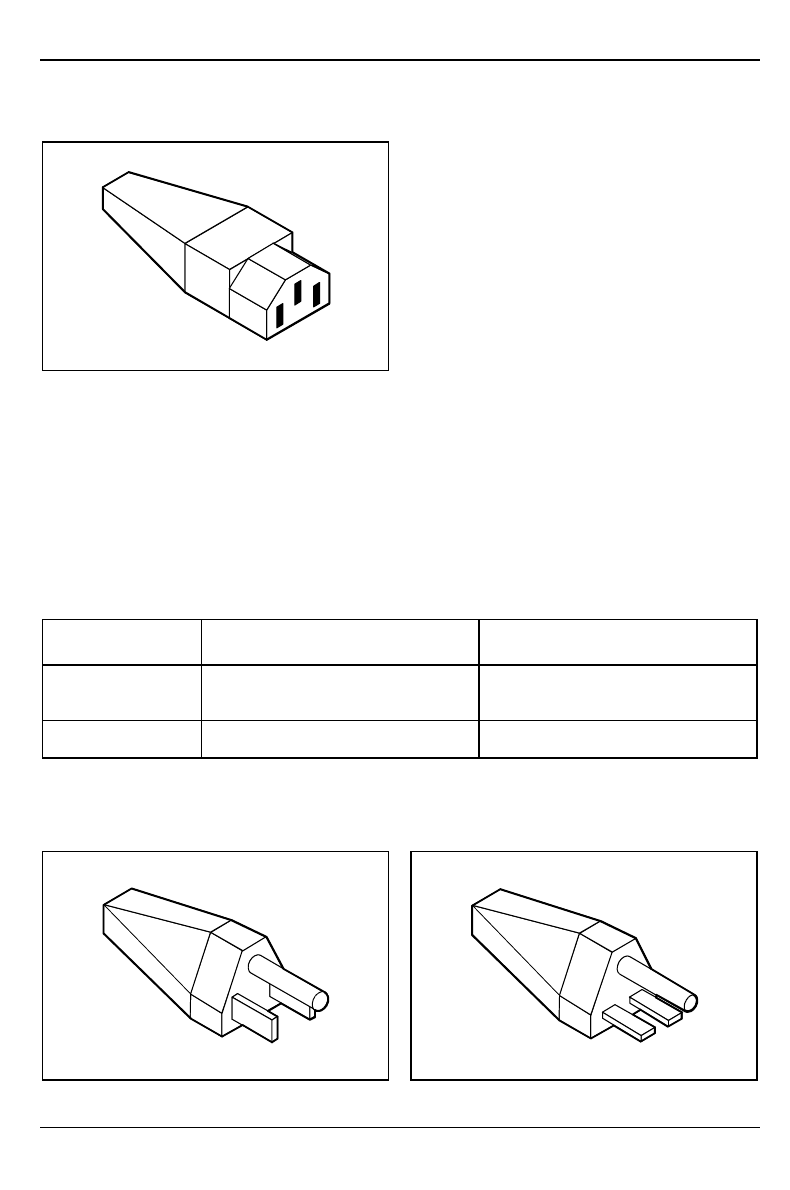
Important notes Manufacturer's notes
6A26361-K516-Z100-3-7619
Power cord selection
The power cord for this unit has been packed
separately and has been selected according to
the country of destination. It must be used to
prevent electric shock. Use the following
guidelines if it is necessary to replace the
original cord set.
The female receptacle of the cord set must meet
CEE-22 requirements (see Figure).
For the United States and Canada
Use a UL listed and CSA labeled cord set consisting of a three conductor cord with a maximum
length of 15 feet.
For units which stand on a desk or table, type SVT or SJT cord sets shall be used.
For units which stand on floor, only SJT type cord sets shall be used.
The cord set must be selected according to the current rating for your unit. Please consult Table A
for the selection criteria for power cords used in the United States and Canada.
Table A:
Cord Type Size of Conductors
in Cord Maximum Current
Rating of Unit
SJT 18 AWG
16 AWG
14 AWG
10 Amps
12 Amps
12 Amps
SVT 18 AWG
17 AWG 10 Amps
12 Amps
For units set at 115 V:
use a parallel blade, grounding type attachment
plug rated 15 A, 125 V.
For units set at 230 V (domestic use):
use a tandem blade, grounding type attachment
plug rated 15 A, 250 V.

Transporting the PC Important notes
A26361-K516-Z100-3-7619 7
For units set at 230 V (outside of the United States and Canada):
use a cord set consisting of a minimum AWG according to Table A and a grounding type attachment
plug rated 15 A, 250 V. The cord set should have the appropriate safety approvals for the country in
which the equipment will be installed and should be marked HAR.
For the United Kingdom
Should the plug on the flexible cord not be of the type for your socket outlets, do not use an adapter
but remove the plug from the cord and discard. Carefully prepare the end of the supply cord and fit a
suitable plug.
WARNING
THIS APPLIANCE MUST BE EARTHED
IMPORTANT
The wires in this mains lead are colored in accordance with the following code:
Green and Yellow: Earth
Blue: Neutral
Brown: Live
As the colors of the wires in the mains lead of this appliance may not correspond with the colored
markings identifying the terminals in your plug, proceed as follows:
• The wire which is colored Green and Yellow must be connected to the terminal in the plug
which is marked with the letter E or by the earth symbol or colored Green or Green and Yellow.
• The wire which is colored Blue must be connected to the terminal which is marked with the
letter N or colored Black.
• The wire which is colored Brown must be connected to the terminal which is marked with the
letter L or colored Red.
Transporting the PC
!Transport all parts separately, and in their original packaging or in a packaging which
protects them from knocks and jolts, to the new site. Do not unpack them until all transport
maneuvers are completed.
Never drop the monitor (risk of implosion)!
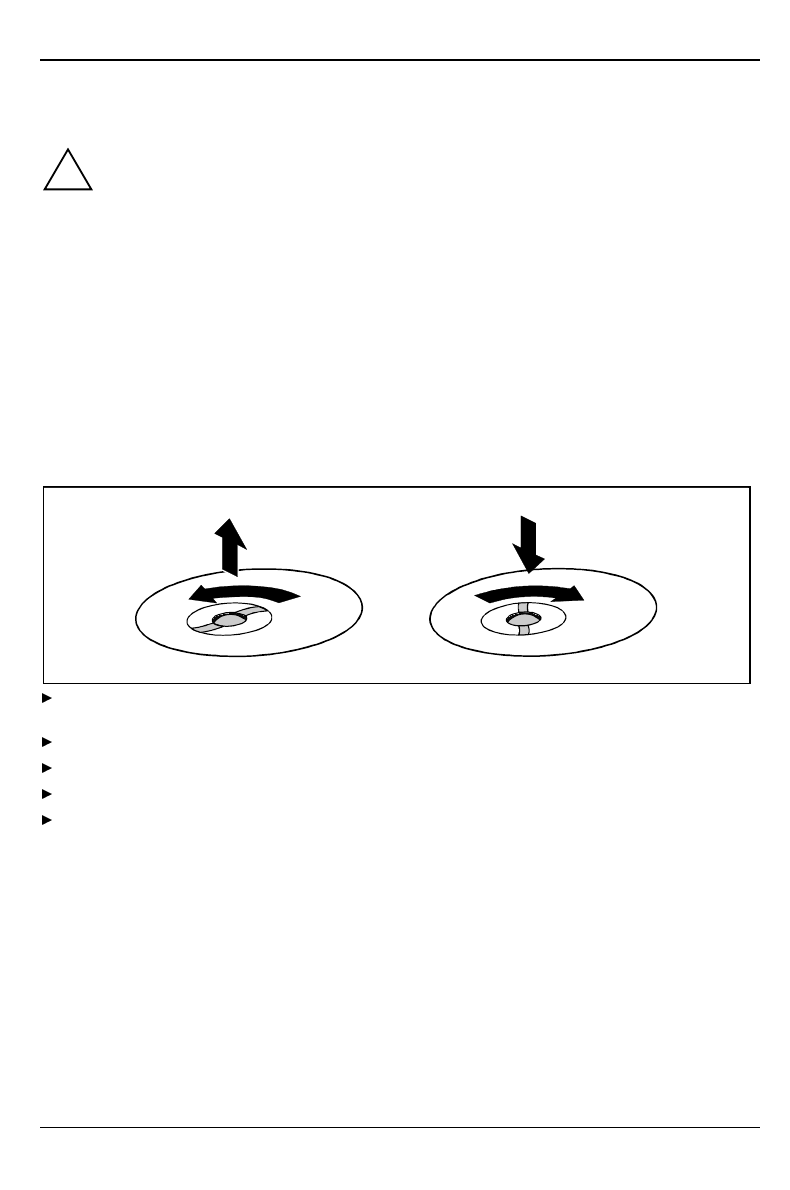
Important notes Cleaning the PC
8A26361-K516-Z100-3-7619
Cleaning the PC
!Turn off all power and equipment switches and pull the power plug out of the grounded
power outlets.
Do not clean any interior parts yourself, leave this job to a service technician.
Do not use any cleaning agents that contain abrasives or may corrode plastic.
Ensure that no liquid enters the system.
Ensure that the ventilation areas of the system unit and the monitor are free.
Cleaning the system unit and the monitor
Wipe the system unit and monitor casing with a dry cloth. If particularly dirty, use a cloth which has
been moistened in mild domestic detergent and then carefully wrung out.
Cleaning the keyboard and the mouse
Use a cloth for disinfection to clean the keyboard and the mouse.
Remove the retaining ring on the underside of the mouse and then clean the mouse mechanism and
the rotating ball.
1
23
4
Using both thumbs exert downward pressure on the notches of the retaining ring and turn the
ring anticlockwise (1).
Remove the retaining ring and the rotating ball from the mouse (2).
Clean the three small wheels in the mouse and the ball with a lint-free cloth.
Replace the ball and the retaining ring (3).
Using both thumbs exert downward pressure on the notches of the retaining ring (4) and turn
the ring clockwise. You must feel the ring engage.

A26361-K516-Z100-3-7619 9
Preparation for use and operation
!Please take note of the safety information in the chapter "Important notes".
Unpacking and checking the delivery
It is recommended not to throw away the original packaging material! It may be required for
reshipment at some later date.
Unpack all the individual parts.
Check the delivery for damage incurred during transport.
Check whether the delivery agrees with the details in the delivery note.
Should you discover that the delivery does not correspond to the delivery note, notify your local
sales office immediately.
iIf you have received drives or boards with your PC, please do not install them until after
first-time setup. How to install drives and boards is described in the chapter "System
expansions".
Preparing the PC for use
First-time setup includes the connection of the devices (monitor, mouse, keyboard etc.) and the
setup of the supplied software.
When you set up the PC for the first time, you should carry out the following steps in the order
shown:
1. Decide where you are going to use the PC.
2. Connect the external devices to the system unit.
3. Check the rated voltage of the system unit and connect it to the line voltage.
4. Switch the PC on and follow the instructions on the screen.

Preparation for use and operation Setting up the PC
10 A26361-K516-Z100-3-7619
Setting up the PC
!When installing your PC, give consideration to the recommendations and safety notes in
the manual "Safety, Guarantee and Ergonomics".
Set up the PC only in its correct orientation. The points to observe are illustrated on the
following pages.
We recommend that you place your equipment on a surface with good anti-slip qualities.
In view of the multitude of different finishes and varnishes used on furniture, it is possible
that the rubber feet of the devices will mark the surface they stand on.
Do not expose the PC to extreme environmental conditions (see chapter "Technical
data"). Protect it from dust, humidity and heat.
Provide at least 200 mm of clearance on the left, in front of and behind the ventilator area
of the system unit to ensure adequate ventilation. Do not cover the ventilation areas of the
monitor and the fan.
Do not place several system units one above the other.
Connecting devices
!The power plug must be disconnected!
Read the documentation on the external device before connecting it.
Do not connect or disconnect cables during a thunderstorm.
Always take hold of the actual plug body. Never unplug a cable by pulling the cable itself!
Connect and disconnect the cables in the order described below.
Connecting cables
• Turn off all power and equipment switches.
• Unplug all power plugs from the grounded power outlets.
• Connect all cables at the system unit and peripherals. You must observe the information
provided in the chapter "Important notes".
• Plug all data communication cables into the utility sockets.
• Plug all power cables into the grounded power outlets.
Disconnecting cables
• Turn off all power and equipment switches.
• Unplug all power plugs from the grounded power outlets.
• Unplug all data communication cables from the utility sockets.
• Disconnect all cables from the system unit and peripherals.
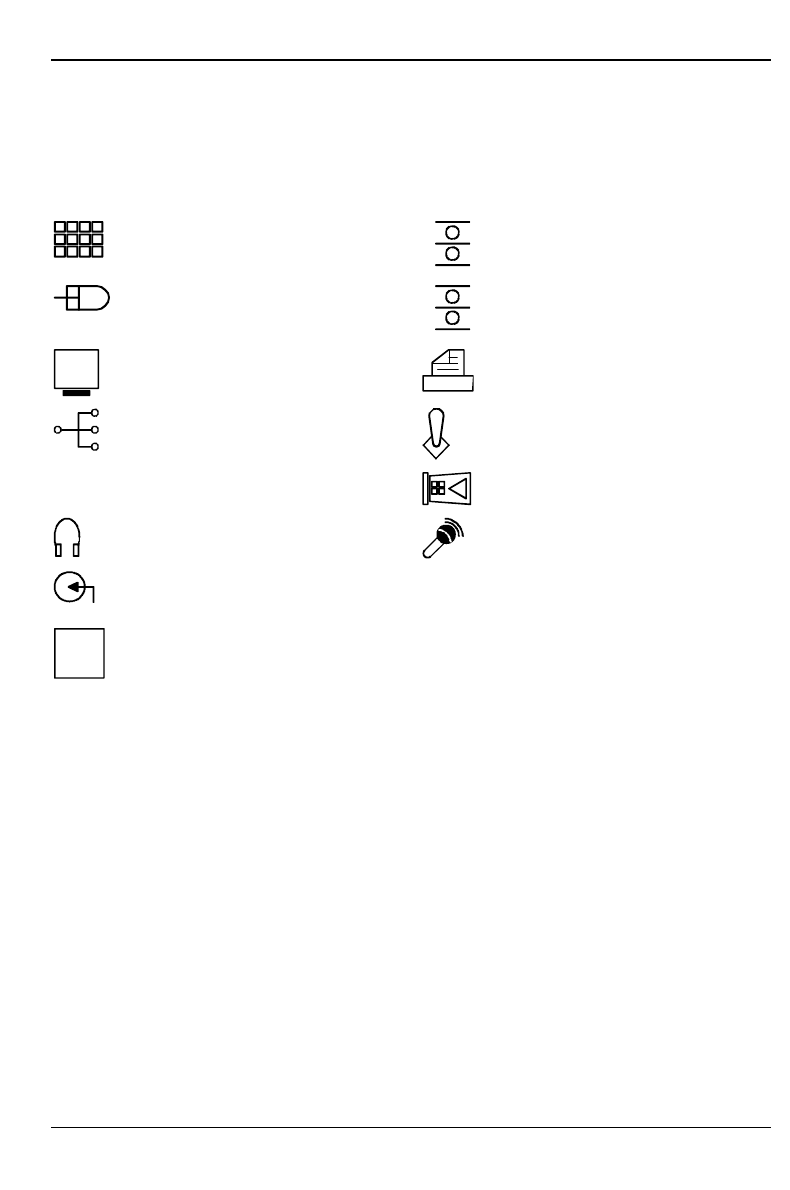
Connecting devices Preparation for use and operation
A26361-K516-Z100-3-7619 11
Ports for external devices
The ports for external devices are on the rear and on the front of the system unit. The ports
available on your device depend on the configuration level you have selected. The standard ports
are marked with symbols like those below or similar symbols. Exact details of the position of the
ports are supplied in the Technical Manuals for the boards.
Keyboard port Serial port 1
PS/2 mouse port Serial port 2
Video connector Parallel interface
USB - Universal Serial Bus Game port
LAN port Chipcard reader
Audio output (Line out) Microphone jack
Audio input (Line in)
iSome of the devices that you connect require special drivers (see the documentation for
the connected device and for the operating system).
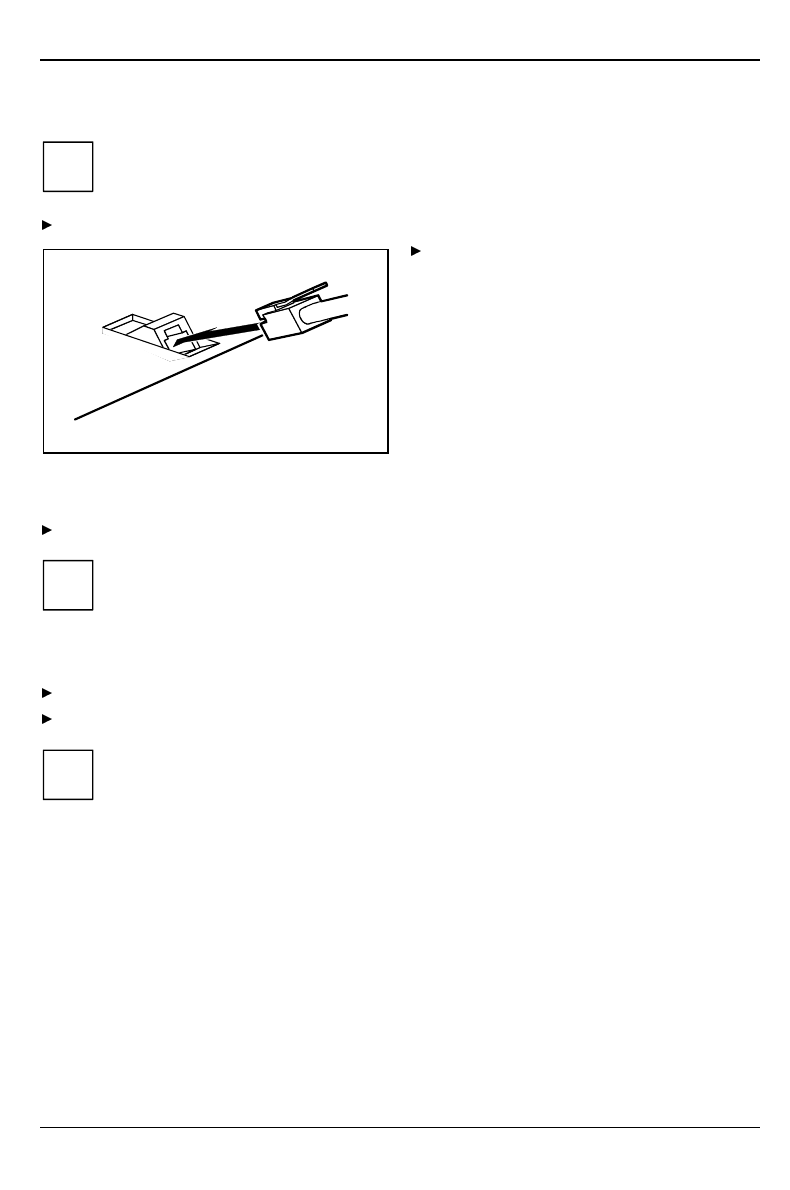
Preparation for use and operation Connecting devices
12 A26361-K516-Z100-3-7619
Connecting the keyboard
iUse only the keyboard cable supplied.
Plug the round plug of the keyboard cable into the keyboard port on the system unit.
Plug the other connector of the keyboard
cable into the socket on the underside of
the keyboard.
Connecting the mouse
Plug the connector of the mouse cable into the mouse port.
iIf you do not attach a mouse at the PS/2 mouse port, you can disable the mouse
controller in the BIOS-Setup in order to free the IRQ12 for a different application.
Connecting devices with serial or parallel port
Connect the data cable to the external device.
Connect the data cable of the external device to the appropriate port on the system unit.
iMost devices that you connect to the serial or parallel port require special drivers. Your
operating system already includes many drivers . But if the driver you need is not on the
hard disk please install it from the floppy disk supplied with the device or with the
application program.
If you need to change the default settings of the serial or parallel port (e.g. address,
interrupt), you can do so in the BIOS Setup. The default setting for the interfaces are
described in the Technical Manual for the system board or in the "BIOS Setup" manual.
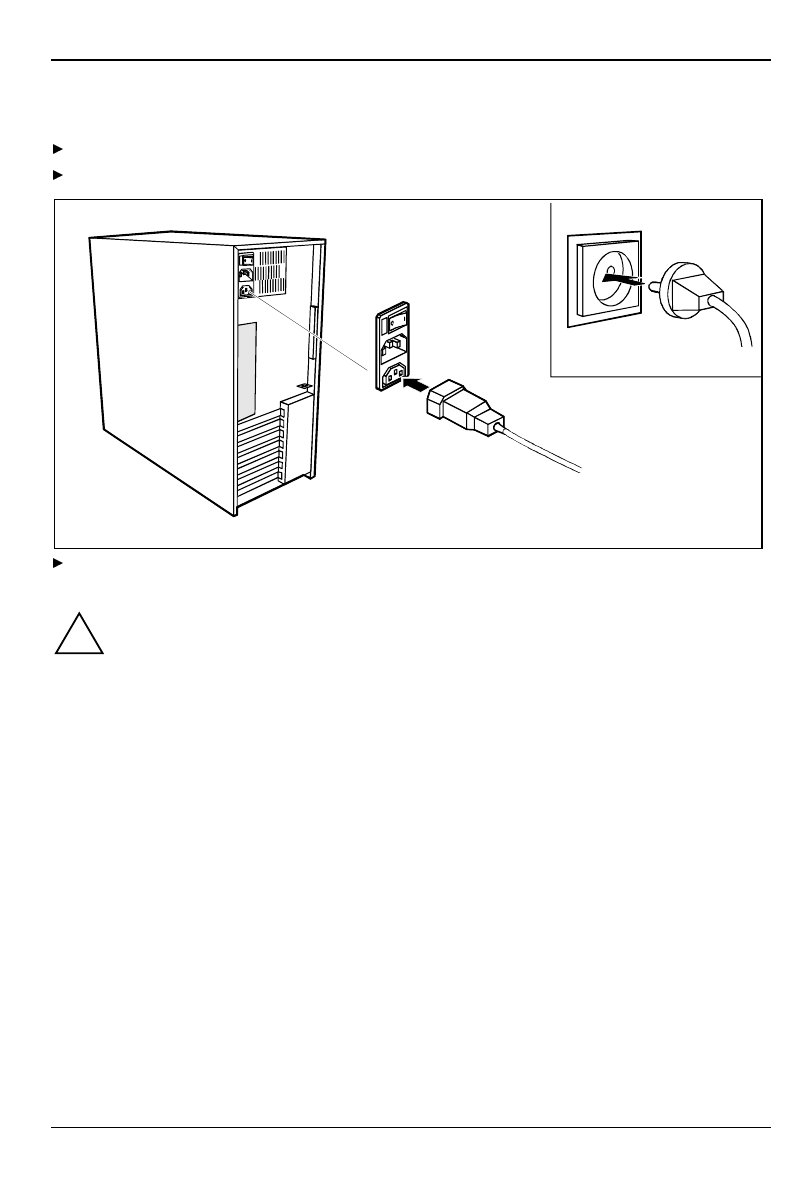
Connecting devices Preparation for use and operation
A26361-K516-Z100-3-7619 13
Connecting the monitor to the line voltage
Prepare the monitor as described in the Operating Manual for the monitor.
Plug the data cable of the monitor into the monitor port of the system unit.
2
1
Depending on the connector, plug the monitor power cable into either the system unit (1) or the
grounded power outlet (2).
!You may only plug the monitor power cable into the monitor connector if the rated current
of the monitor is less than 1.5 A (230 V) or 3 A (115 V). The rated current for the monitor
is also given on the monitor itself and in the Operating Manual for the monitor.
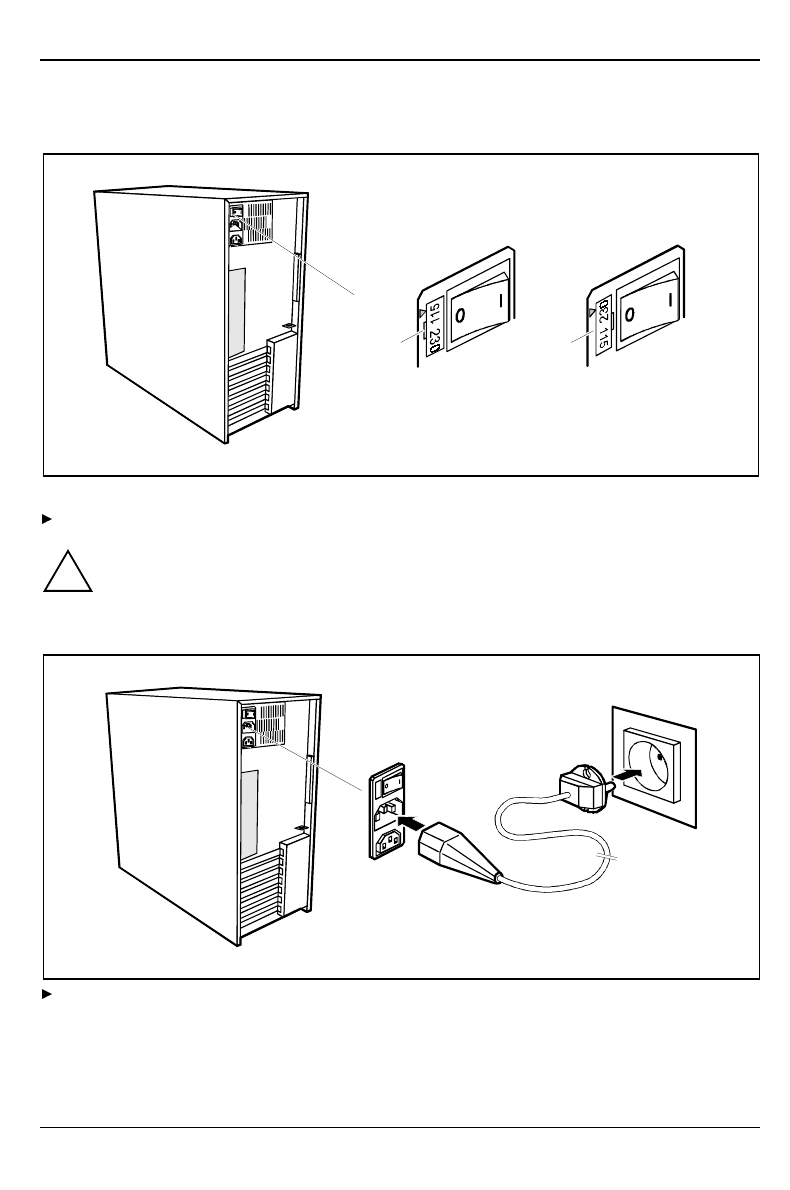
Preparation for use and operation Connecting the PC to the line voltage
14 A26361-K516-Z100-3-7619
Connecting the PC to the line voltage
100 V - 125 V 200 V - 240 V
1 1
1 = Notch for inserting the screwdriver
Check the rated voltage.
!The value marked with an arrow must agree with the local line voltage:
115 = 100 V to 125 V 230 = 200 V to 240 V
If the rated voltage does not agree with the local line voltage, lift out the plug-in unit with a
screwdriver (1), turn it and replace it.
1
2
Plug the system unit's power cable into the system unit (1) and then into the grounded power
outlet (2).
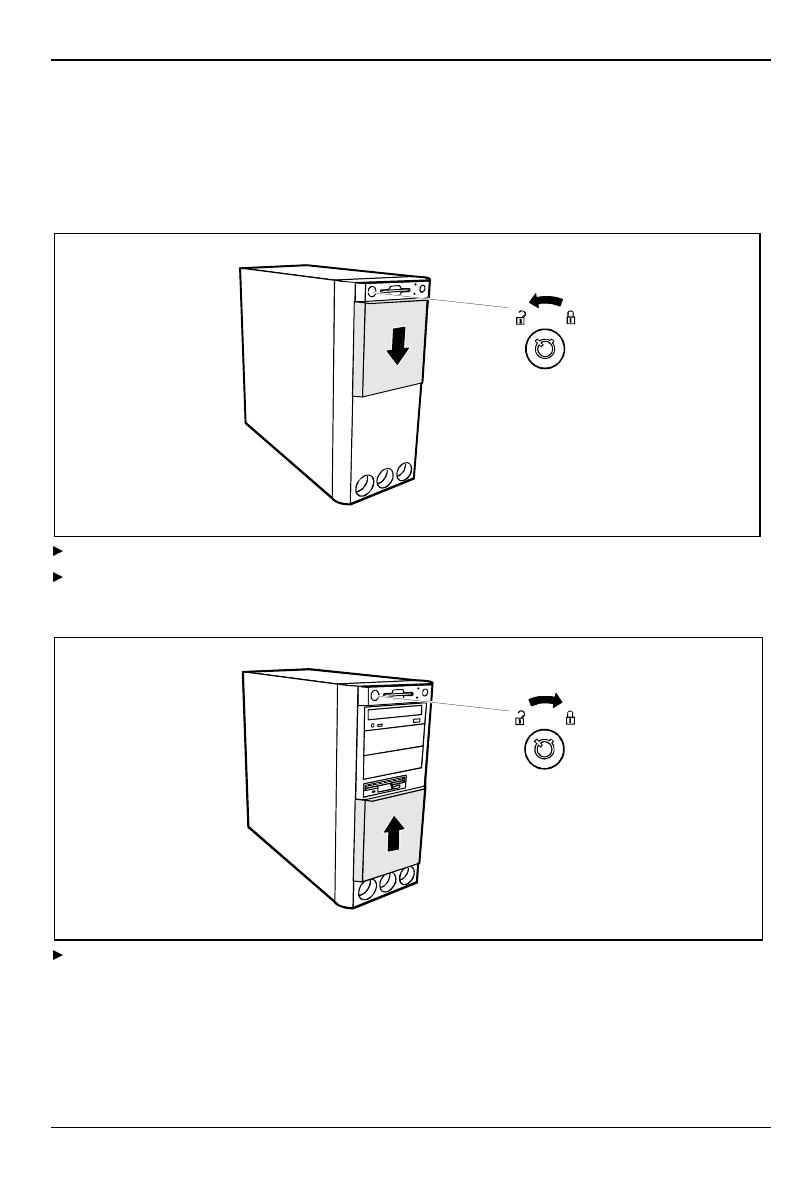
Unlocking/locking the system unit Preparation for use and operation
A26361-K516-Z100-3-7619 15
Unlocking/locking the system unit
With the casing lock you can mechanically lock the system unit, and with the drive cover you can
block access to the drives.
Unlocking the system unit
1
2
Turn the key counterclockwise (1).
Slide the drive cover in direction of the arrow (2).
Locking the system unit
1
2
Slide the drive cover in direction of the arrow (1) and turn the key clockwise (2).
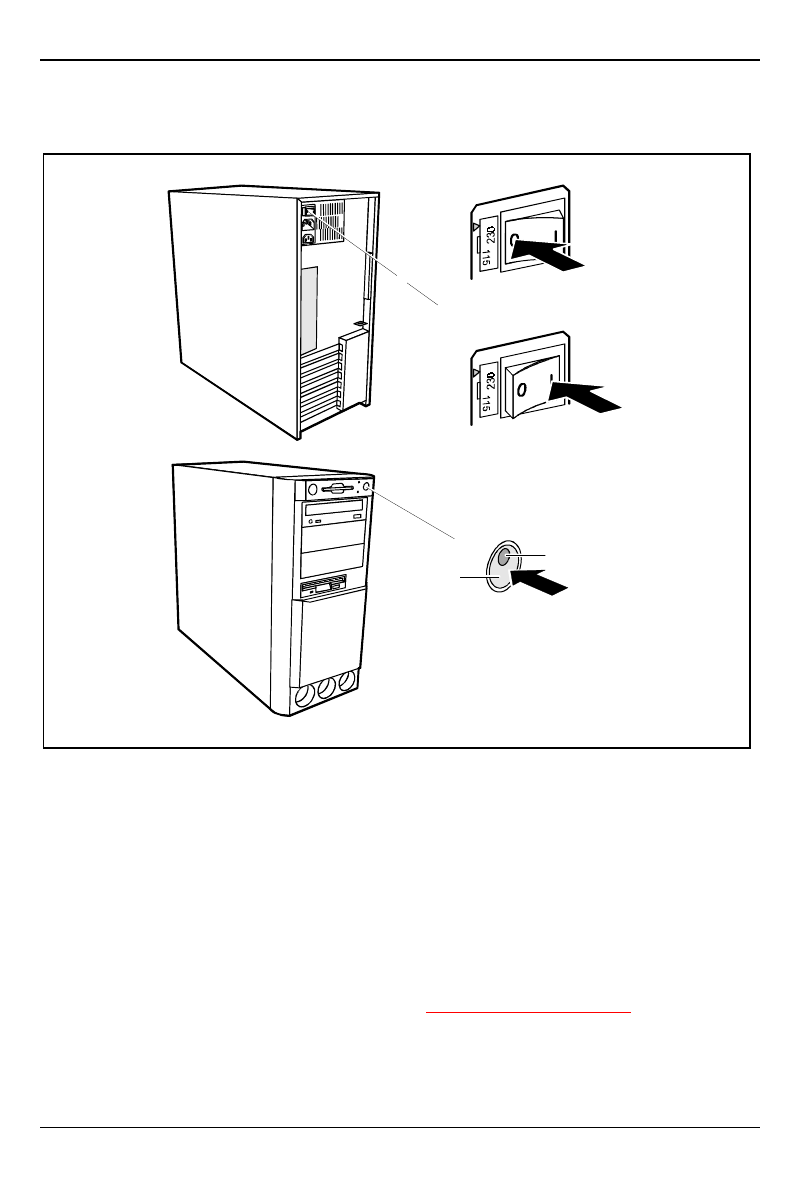
Preparation for use and operation Switching the PC on and off
16 A26361-K516-Z100-3-7619
Switching the PC on and off
1
0
I
3
2
1 = Main switch
2 = ON/OFF switch
3 = Power-on indicator
0 = System unit is switched off
I = System unit is ready-to-operate
System unit is off
The main switch (1) is in position 0, the power-on indicator (3) does not light, and the ON/OFF
switch (2) is disabled.
System unit is ready-to-operate
The main switch (1) is in position I and the power-on (3) indicator lights up orange or flashes
green/orange. In this mode, you can switch the system unit on with the ON/OFF switch (2). The
"ready-to-operate" status corresponds to the "stand-by" status of a TV set. The exact description of
the power-on indicator (3) is contained in the section "Indicators on the system unit".
System unit is on
The main switch (1) is in position I and the power-on indicator (3) lights up green. The system unit
can be switched ready-to-operate at the ON/OFF switch (2).
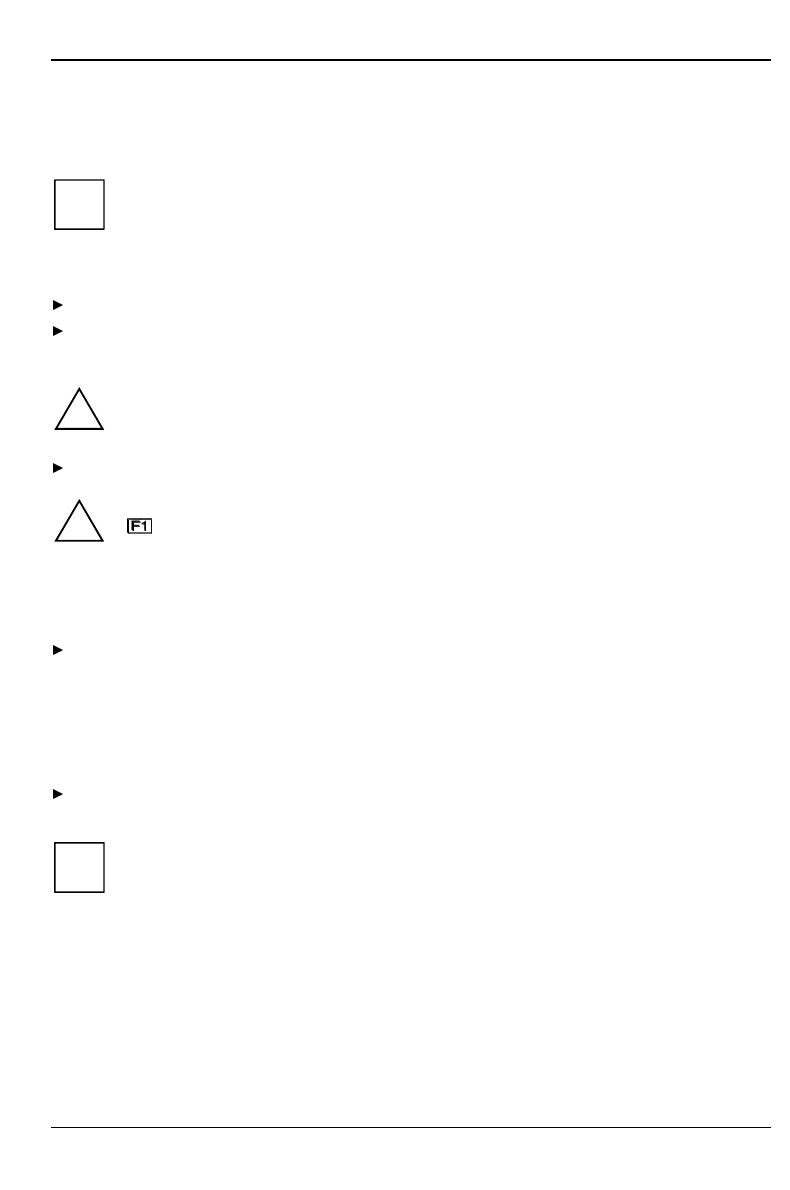
Switching the PC on and off Preparation for use and operation
A26361-K516-Z100-3-7619 17
Switching on the PC for the first time
When you switch on your PC for the first time the supplied software is set up and configured.
iIf the PC is integrated into a network, the user and server details as well as the network
protocol are required. Contact your network administrator if you have any questions about
these details.
The license number for Windows is printed on the front cover of the Windows manual
supplied.
Switch your monitor on.
Switch the system unit on with the ON/OFF switch.
The power-on indicator lights green and the PC is started.
!While the PC boots, the screen remains dark for up to a minute depending on the system
configuration. To see the start-up messages, you can switch off this standard setting in
the BIOS Setup in the Quiet Boot entry.
Adjust the brightness if necessary (see the Operating Manual for the monitor).
!Some variants require you to start the software installation by pressing the function key
.
Once the installation has been started the PC must not be switched off.
You should only reboot the PC during installation if you are requested to do so. Otherwise
the installation will be not be performed correctly. If a fault occurs in the installation the
contents of the hard disk must be completely restored.
During installation follow the instructions on the screen.
Consult the operating system manual if there is anything unclear about the requested input data.
Some system configurations do not include a Windows CD in the delivery package. In this case you
should create a backup copy after installing Windows so that you can restore the hard disk contents
in an emergency.
You need about 40 diskettes for this.
Create Windows diskettes with the MSCSD backup program (create system diskettes) and label
them using the labels supplied.
iYou will find further information about the system, drivers, utilities, updates, and manuals
etc. on the "Drivers & Utilities" CD supplied.

Preparation for use and operation Switching the PC on and off
18 A26361-K516-Z100-3-7619
Switching on the PC
Switch the monitor on (see the Operating Manual for the monitor).
Switch the system unit on with the main switch at the rear of the system unit.
If the power-on indicator lights orange, press the ON/OFF switch at the front of the system unit.
The power-on indicator lights green and the PC is started.
!While the PC boots, the screen remains dark for up to a minute depending on the system
configuration. To see the start-up messages, you can switch off this standard setting in
the BIOS Setup in the Quiet Boot entry.
If you have assigned the system password, you must enter this when requested to do so,
in order to start the operating system.
Switching off the PC
Shut down the operating system properly. Windows in the Start menu via the Quit function.
If the operating system does not automatically switch the system unit off, switch the system
unit to ready-to -operate by pressing the ON/OFF switch or turn it off by pressing the main
switch when requested to do so.
If the system unit is ready-to-operate, the power-on indicator lights up orange. The system unit
consumes a minimum of energy and can be switched on by an external device (provided that the
remote-on functionality is enabled in BIOS Setup).
When the system unit is switched off with the main switch the power-on indicator goes off after
approx. 15 seconds. The system unit no longer uses any power.
iThe main switch and the ON/OFF switch do not disconnect the system unit from the line
voltage. To disconnect the line voltage completely, remove the power plug from the
grounded power outlet.
Switch the monitor off (see the Operating Manual for the monitor).
Placing a PC (with soft power off function) in a ready-to-operate state by means of software
Prerequisite: Your system must support switching off with software and this functionality must be
enabled in BIOS Setup (Soft Power OFF - Enabled). In addition, the soft off software must be installed
on Windows NT systems.
You can switch your PC ready-to-operate under Windows 9x or Windows NT via the
shutdown the Computer menu or by using the DeskOff program.
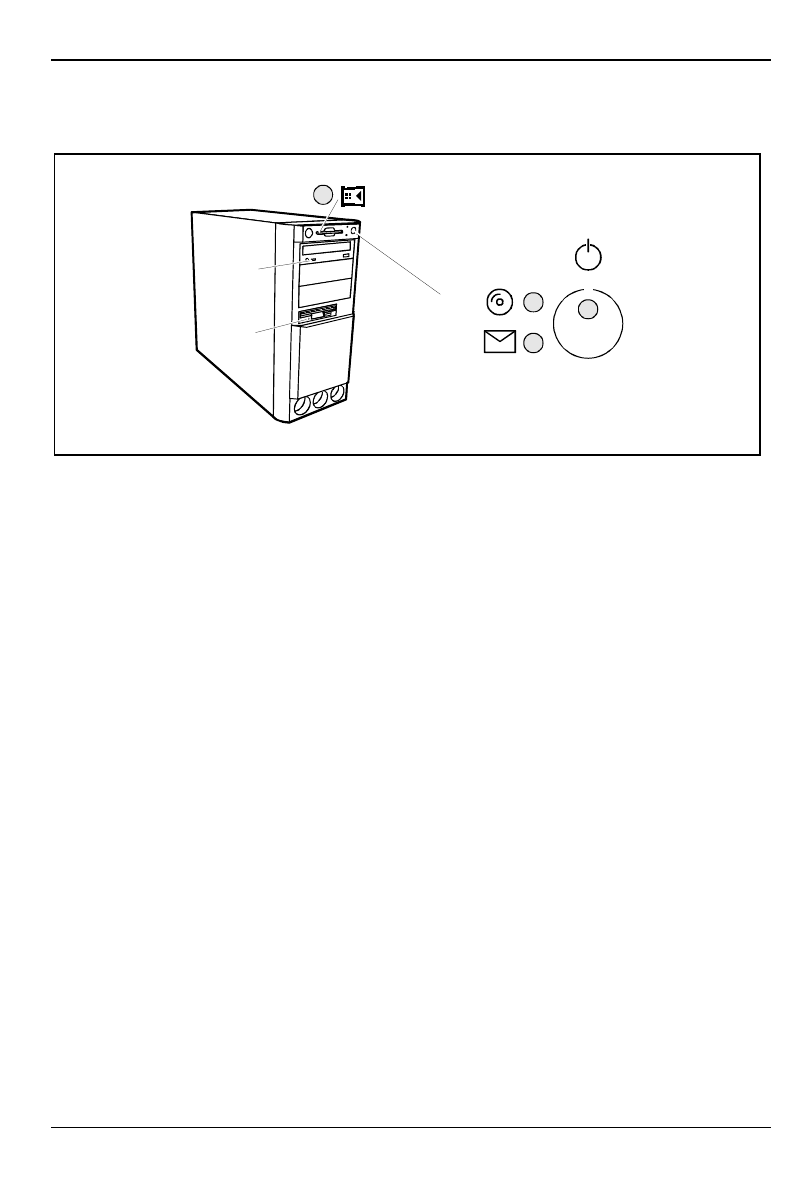
Indicators on the system unit Preparation for use and operation
A26361-K516-Z100-3-7619 19
Indicators on the system unit
6
1
3
4
5
2
1 = Floppy disk indicator
2 = CD-ROM indicator
3 = Chipcard reader indicator
4 = Hard disk indicator
5 = Message indicator
6 = Power-on indicator
1 - Floppy disk indicator
The indicator lights up when the floppy disk drive of the system unit is accessed. You may only
remove the floppy disk when the indicator is dark.
2 - CD-ROM indicator
The indicator lights up when the CD-ROM drive of the system unit is accessed. You may only
remove the CD when the indicator is dark.
3 - Chipcard reader indicator
The indicator lights up when the chipcard reader is accessed. You may only remove the chipcard
when the indicator is dark.
4 - Hard disk indicator
The indicator lights up when the hard disk drive of the system unit is accessed.
5 - Message indicator
The display glows or flashes when the system has received a message or has reported a
malfunction. A detailed description can be found in the Technical Manual for the system board.
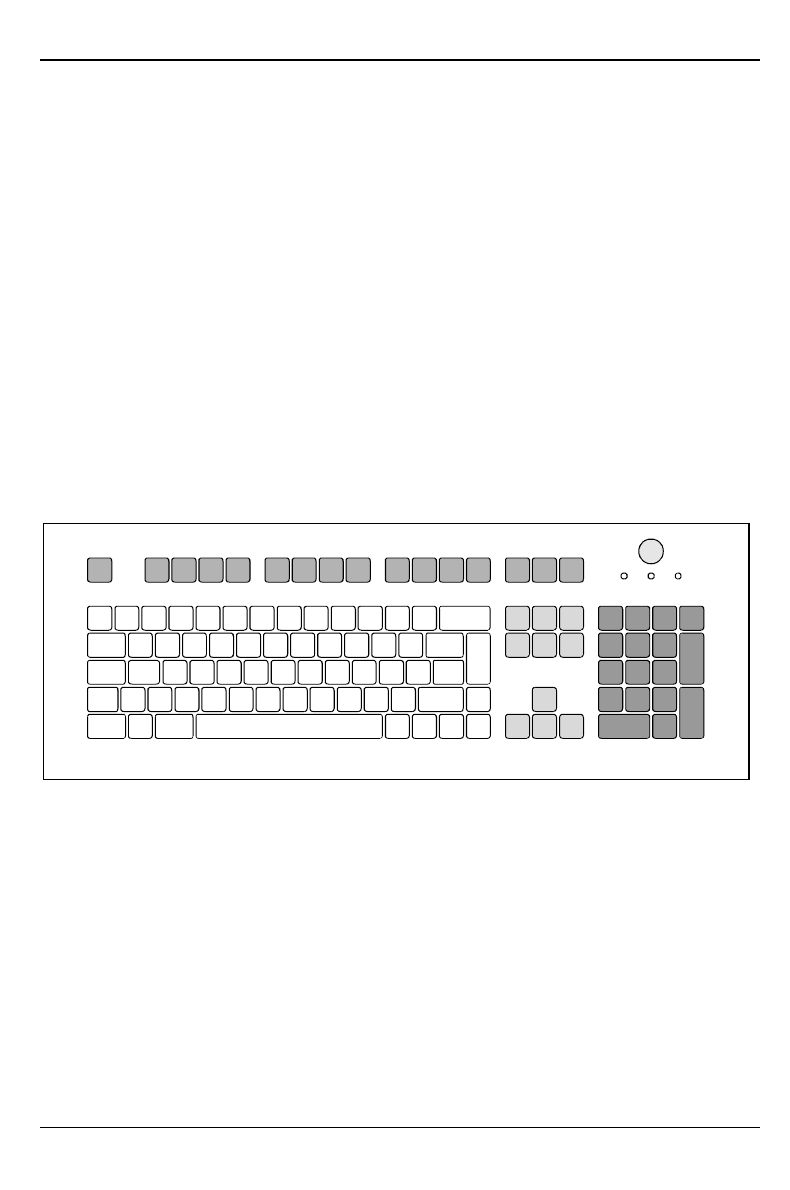
Preparation for use and operation Keyboard
20 A26361-K516-Z100-3-7619
6 - Power-on indicator
− green:
The System unit is on.
− orange:
The System unit is ready-to-operate.
In this mode the PC consumes very little power and can be switched on at the ON/OFF
switch. If the remote-on function is Enabled in the BIOS Setup, the system unit can be
switched on by an incoming message (e. g. fax, telephone call).
− flashes green/orange:
The indicator only flashes on systems which support the ACPI function (Advanced
Configuration and Power Interface).
The system unit is in the energy-saving mode (standby). After being switched on with the
ON/OFF switch, the PC returns to the state it was in before the energy-saving mode. In
the energy-saving mode the system unit may not be switched off with the main switch or
disconnected from the mains supply, as this may otherwise result in data loss.
− does not glow:
The system unit is switched off.
Keyboard
1
34
5
2
1 = function keys
2 = ON/OFF switch (optional)
3 = alphanumeric keypad
4 = cursor control keys
5 = numeric keypad (calculator keypad)
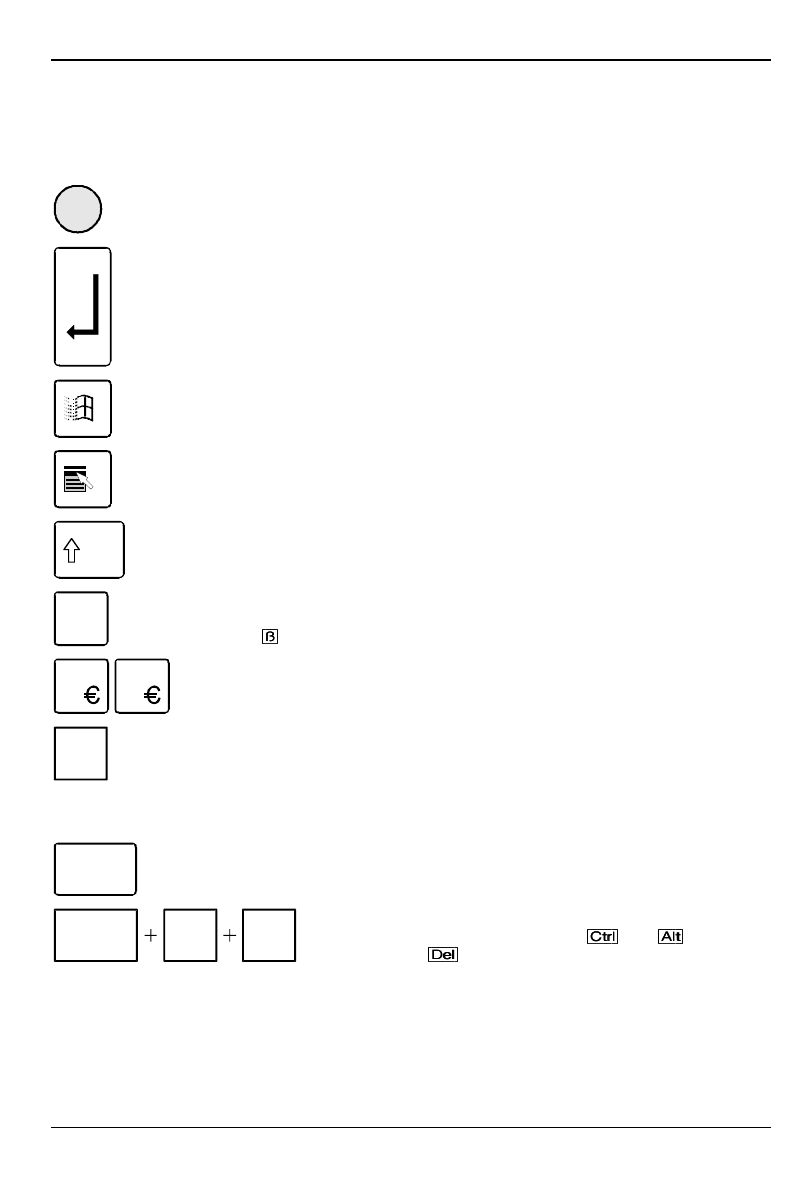
Keyboard Preparation for use and operation
A26361-K516-Z100-3-7619 21
Important keys and key combinations
The following description of keys and key combinations refers to MS Windows. Details of other keys
and key combinations can be found in the documentation of the relevant application program.
ON/OFF switch
Depending on the setting in the BIOS setup, the system can be switched on, off or
on and off with this switch.
Enter key
confirms or starts the marked selection. The enter key is also referred to as the
"Return" key or "Carriage Return".
Start key
invokes the START menu of Windows.
Menu key
invokes the menu for the marked item (Windows).
Shift key
enables upper-case letters and the upper key symbols to be displayed.
Alt Gr Alt Gr key (e.g. German keyboard)
produces a character shown on the right-hand side of a key (e. g. the character "\"
on the key of the German keyboard).
%
5
$
4
Euro key (American and English variant)
enables the output of the euro symbol (Windows).
Num
Lock
Num Lock key
by pressing the Num Lock key you switch between the upper- and lower-case
levels of the calculator keypad.
At upper-case level (Num Lock indicator lit) the digit and comma keys are active.
At lower-case level (Num Lock indicator not lit) the cursor control functions are
active in the calculator keypad.
Ctrl Ctrl key
starts key combination actions.
Ctrl Alt Del
Warm boot
restarts your PC. First hold down the and key, and
then press the key. With Windows 95 the Task Manager
appears first. The warm start is then carried out the second
time.
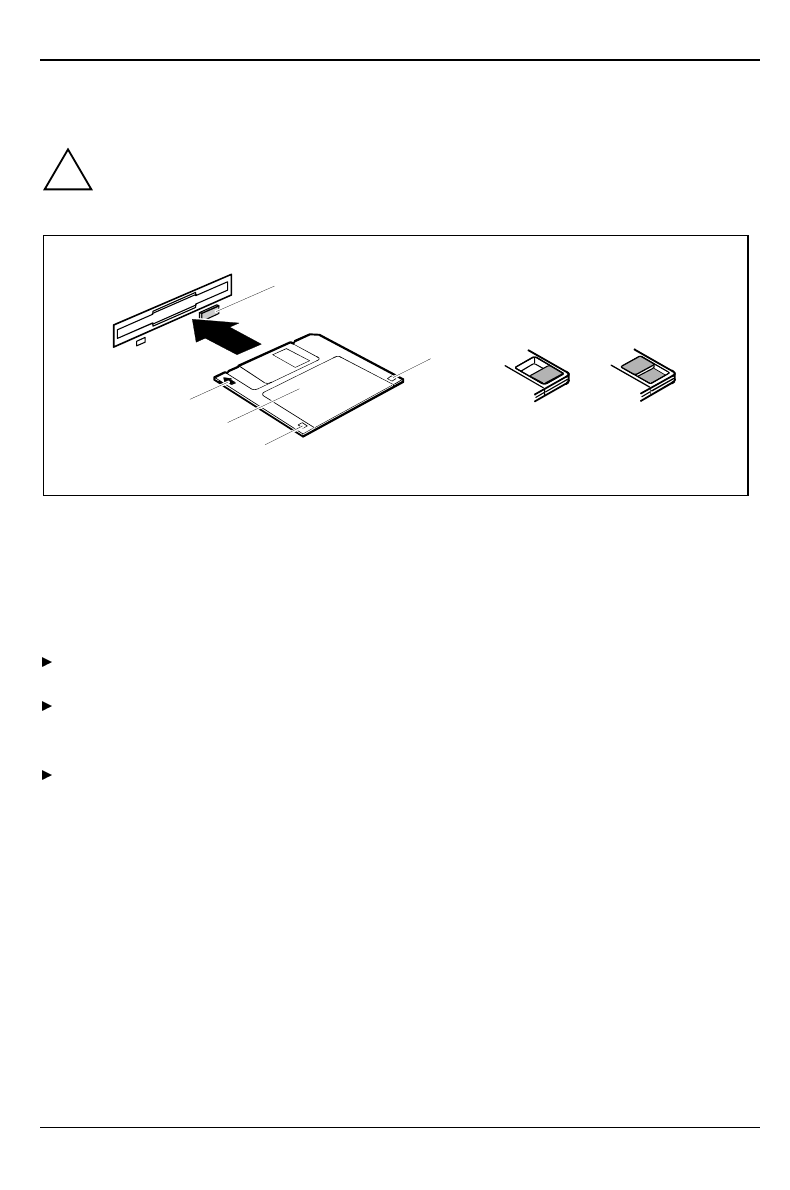
Preparation for use and operation Working with floppy disks
22 A26361-K516-Z100-3-7619
Working with floppy disks
!Follow the instructions supplied by the vendor of the floppy disks.
Never clean the floppy disk drives with cleaning disks. Even just one attempt would
destroy the read/write head in the disk drive within 20 seconds.
3
2
1
5
6
47
1 = Insertion direction
2 = Label area
3 = Write protection tab for a 720 Kbyte or a 1.44 Mbyte floppy disk
4 = Identification of a 1.44 Mbyte floppy disk or write protect tab on a 120 Mbyte floppy disk
5 = Eject button for inserted floppy disks
6 = Floppy disk is write protected
7 = Floppy disk is not write-protected
To insert a floppy disk, push it into the drive in the insertion direction (1) until it engages. The
label should be facing upward.
To remove the floppy disk, press the eject button (5).
The write-protect slider enables you to protect the data on the floppy disk from inadvertent
overwriting or deletion.
To protect the data on the floppy disk from being overwritten, push the write-protect slider to
position (6). The hole is now visible.
To remove write protection, push the slider to position (7). The hole is now covered.

Settings in BIOS Setup Preparation for use and operation
A26361-K516-Z100-3-7619 23
Settings in BIOS Setup
The BIOS Setup
menu allows you to set your hardware configuration and system functions. When the
PC is delivered, the default entries are valid (see Technical Manual for the system board or in the
manual "BIOS Setup"). You can customize these settings to your requirements in BIOS Setup.
The technical manual of the system board or the "BIOS Setup" manual shows you how to open and
use the BIOS Setup. The menus and setting options provided by BIOS-Setup are also described in
detail.
Property and data protection
The software functions and mechanical lock on your PC enables you to protect your system and
personal data in a number of ways against unauthorized access. By combining these options, you
can achieve optimum protection for your system.
Locking the system unit mechanically
With the casing lock you can mechanically lock the system unit, and with the drive cover you can
block access to the drives.
Access authorization via chipcard
In systems that are equipped with a chipcard reader, access can be restricted to users who have a
corresponding chipcard.
Security functions under Windows
Under MS-Windows you can activate a screen saver and protect it with a password. Only those
users who know the password can deactivate the screen saver and access any open files. Detailed
information on screen savers under MS Windows is provided by the associated help function.
Security functions under Windows NT
You can use the SSLAUNCH program to start the screen saver POWERSAVER immediately. These
programs are located on the "Drivers & Utilities" CD.
Information on POWERSAVER and SSLAUNCH can be found in the POWERSAV.HLP and
SSLAUNCH.EXE files.
Security functions under Windows 9x
You can lock the keyboard and mouse with a password-protected screen saver.
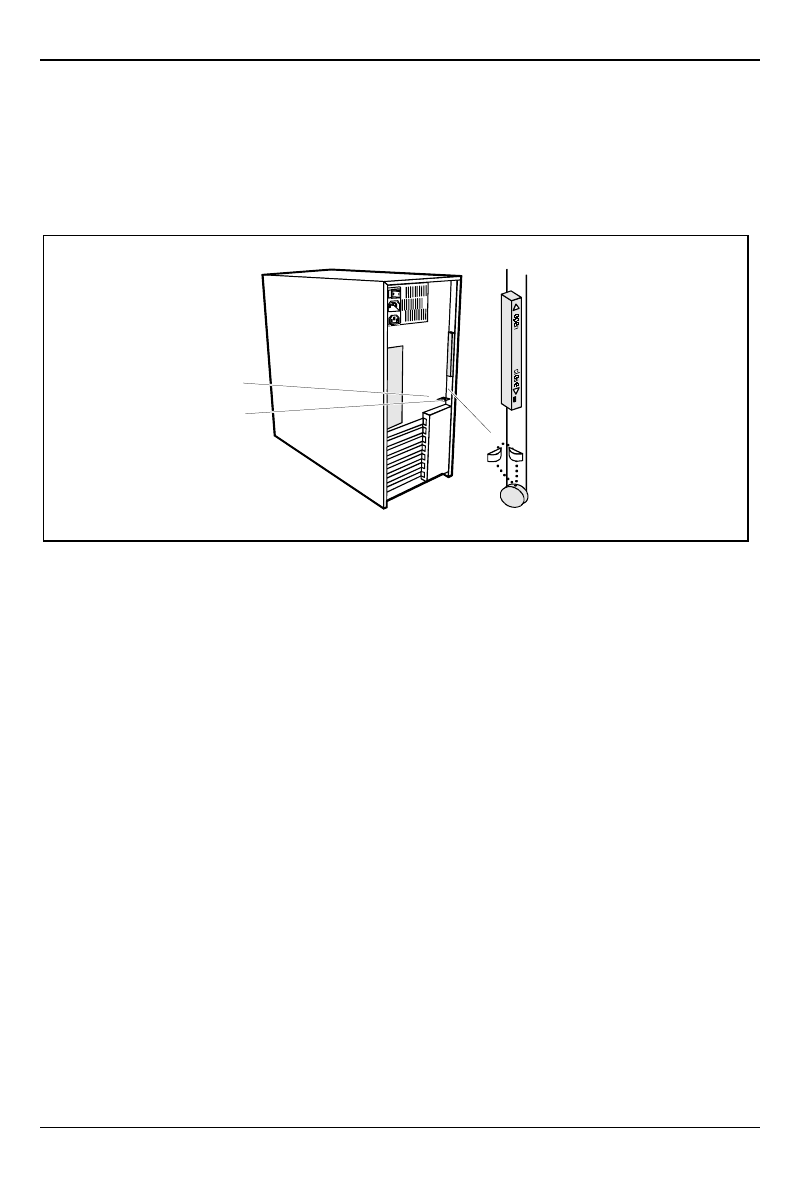
Preparation for use and operation Property and data protection
24 A26361-K516-Z100-3-7619
Theft protection and lead sealing
With a chain lock and the hole in the tab (1) or with the Kensington Lock device (2) and with a
Kensington MicroSaver you can protect your unit from theft.
To prevent unauthorized persons from opening the system unit, the casing can be lead-sealed. To
do this, use the eyes on the back of the casing.
1
2
BIOS Setup security functions
The Security menu in BIOS Setup offers you various options for protecting your personal data against
unauthorized access, e. g.:
• Preventing unauthorized BIOS Setup calls
• Preventing unauthorized system access
• Preventing unauthorized access to the settings of boards with their own BIOS
• Preventing system booting from the diskette drive
• Activating virus warnings
• Preventing unauthorized writing of diskettes
• Protecting BIOS from overwriting
• Protecting PC from being switched on by an external device
By combining these options, you can achieve optimum protection for your system.
You will find a detailed description of the Security menus and how to assign passwords in the
Technical Manual for the system board or in the "BIOS Setup" manual.

A26361-K516-Z100-3-7619 25
Troubleshooting and tips
!Take note of the safety notes in the manual "Safety, Guarantee and Ergonomics" and in
the chapter "Preparation for use and operation", when you connect or disconnect cables.
If a fault occurs, try to correct it as described:
• in this chapter
• in the documentation of the connected devices
• in the help systems of the software used.
If you fail to correct the problem, proceed as follows:
Switch the PC off.
Make a note of the steps and the circumstances that led to the fault. Also make a note of any
error messages displayed and the Ident-No. of your device.
Contact your sales office or customer service.
Installing new software
When installing programs or drivers, important files may be overwritten and modified. To be able to
access the original data in the case of any problems following installation, you should make a
backup of the your hard disk prior to installation.
Power-on indicator remains dark after you have
switched on your device
This may have the following causes:
The line voltage supply is faulty
Check that the power cable is plugged properly into the system unit and grounded power outlet.
Switch the PC on at the main switch.
Internal power supply overloaded
Disconnect the power plug of the system unit from the grounded power outlet.
Wait for a moment.
Plug the power plug into the grounded power outlet again.
Switch the PC on at the main switch.

Troubleshooting and tips
26 A26361-K516-Z100-3-7619
The screen stays blank
If your screen remains blank this may have the following causes:
Monitor is switched off
Switch your monitor on.
The PC starts
While the PC boots, the screen remains dark for up to a minute depending on the system
configuration. To see the start-up messages, you can switch off this standard setting in the BIOS
Setup in the Quiet Boot entry.
Screen has been blanked
Press any key on the keyboard.
or
Deactivate screen blanking (screen saver). Enter the appropriate password.
Brightness control is set to dark
Set the brightness control to light. For detailed information, please refer to the Operating
Manual supplied with your monitor.
Power cable or monitor cable not connected
Switch off the monitor and the system unit.
Check that the power cable is properly connected to the monitor and system unit or to the
grounded power outlet.
Check that the monitor cable is properly connected to the system unit and monitor (if not
permanently attached).
Switch on the monitor and the system unit.
Wrong monitor has been set under Windows NT
Restart the PC in standard VGA mode.
Set the desired resolution in the Control Panel window using the Display program, and adjust
the monitor display as described in the Operating Manual.
Wrong monitor has been set under Windows 9x
Restart the PC.
If the message Starting Windows 9x appears, press function key .
The Windows 9x start menu appears.
Select the option Safe mode or Safe mode with network support.
Set the correct values for the attached monitor by selecting Start - Settings - Control Panel -
Display - Settings.
The wrong RAM memory modules have been inserted
See the Technical Manual for the system board for information on which memory modules can be
used.

Troubleshooting and tips
A26361-K516-Z100-3-7619 27
No mouse pointer displayed on the screen
Shut down the operating system properly.
Switch the PC off.
Check that the mouse cable is properly connected to the system unit.
If you use an adapter or extension lead with the mouse cable, check the plug-in connection.
Make sure that only one mouse is connected.
Switch the PC on.
The mouse controller must be enabled, if you use a PS/2 mouse. Check in the BIOS Setup that
the mouse controller is enabled.
Check that the mouse driver is properly installed and is present when the application program
is started. Detailed information can be found in the User Guide of the mouse or application
program.
The floppy disk cannot be read or written
Check that the write protection of the floppy disk or the floppy disk drive is activated (refer also
to the Technical Manual of the system board or in the manual BIOS).
Check the relevant entries for Diskette A: or B: in the Main menu of the BIOS Setup.
Check that the floppy disk drive controller is enabled (refer also to the Technical Manual of the
system board or in the manual "BIOS Setup").
Check that the cables of the floppy disk drive are properly connected (refer to chapter "System
expansions").
Time and/or date is not correct
Set the time and/or date. You can set the time and date in the BIOS Setup or in the operating
system.
iIf the time and date are repeatedly wrong when you switch on your PC, the battery is flat.
Change the lithium battery as described in the Chapter "System expansions".
Error messages on the screen
Error messages and their descriptions are listed in the Technical Manual of the system board or in
the "BIOS Setup" manual and in the documentation of the installed software.
Restoring the hard disk contents
Instructions for this purpose can be found in the documentation (booklet) of the
CD "Drivers & Utilities".

Troubleshooting and tips
28 A26361-K516-Z100-3-7619
Tips
The PC cannot be switched off with the ON/OFF switch
Cause: The PC has not been switched on with the ON/OFF switch.
Press the ON/OFF switch again.
Cause: System crash
Press the ON/OFF switch for at least four seconds, until the device switches off.
PC switches on briefly and then off again
The power cable has been plugged in or the device was switched on with the main switch. For
technical reasons, this brief switching on and off is necessary.
Out of system resources
If you have too many applications running at once, you may experience problems due to a lack of
system resources. If this happens, you should close applications you do not require or call the
applications in a different order.
BIOS settings in power management do not become active
The Auto insert notification setting may be active for the CD-ROM drive. This setting causes
Windows 95 to inquire about any modifications on the drive at regular intervals. Because of this the
timer for the idle time cannot time out.
To activate power management, proceed as follows:
In Windows 95, select Start - Settings - Control Panel - System - Device Manager - CD-ROM.
Select the installed CD-ROM drive from the list.
Select Settings.
Deactivate the Auto insert notification box.
CD-ROM drive
Information on the CD-ROM drive can be found in the manual of the CD-ROM drive or on the
"Drivers & Utilities" CD.
Other manuals
Other manuals are contained on the "Drivers & Utilities" CD.

A26361-K516-Z100-3-7619 29
System expansions
!It may be necessary to update the BIOS when carrying out a system expansion or
hardware upgrade. In this instance, please contact our service.
When installing components with a high power loss, make sure that the maximum
permissible temperatures of the individual components are not exceeded
This chapter describes all the activities required to modify your PC hardware (e.g. installing boards
or drives).
Memory and processor upgrading are described in the Technical Manual for the system board.
Read the supplied documentation before installing new drives and/or boards.
Refer to the Technical Manual for the system board before making any extensions on the system
board.
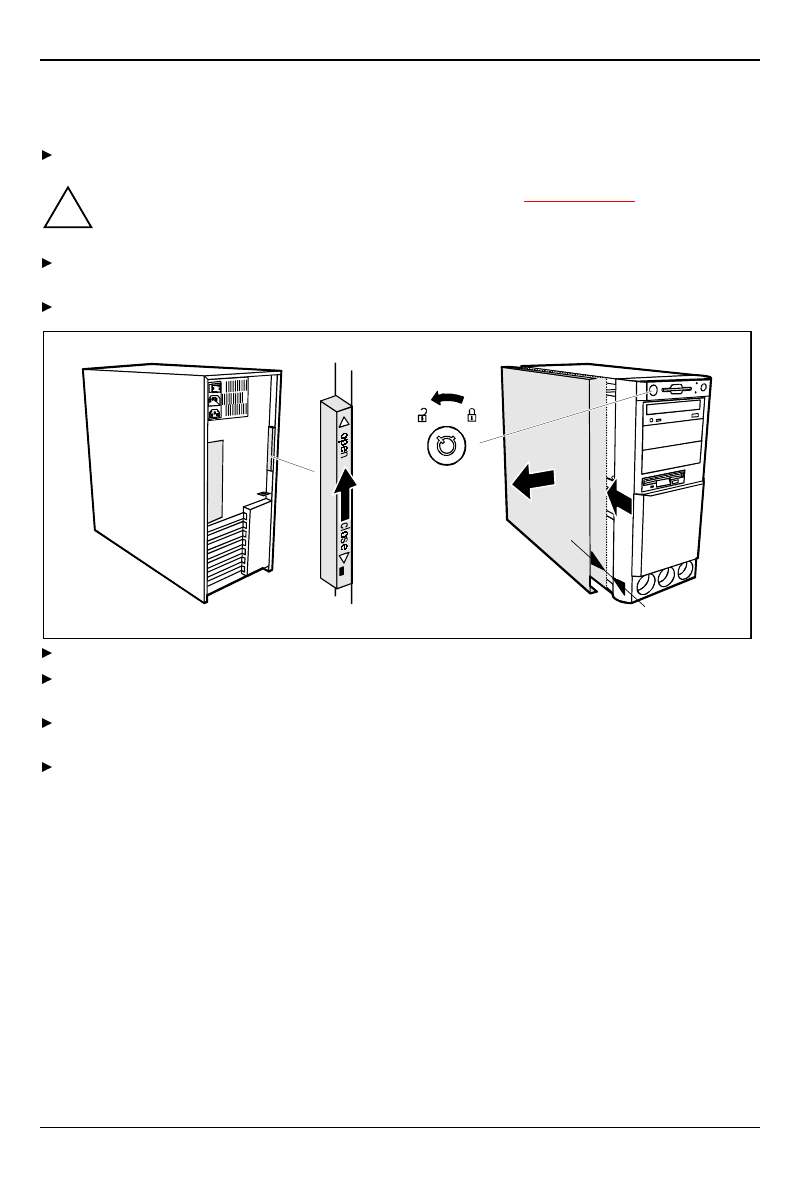
System expansions Opening the system unit
30 A26361-K516-Z100-3-7619
Opening the system unit
Switch the PC off.
!Please take note of the safety information in the chapter "Important notes".
Pull the power plug out of the power outlet!
If any cables attached to the system unit are obstructing you, pull out the connectors on the
system unit.
Place the system unit in a convenient working position.
1
3
4
2
a
Unlock the system unit (1).
Unlock the left-hand side cover with the locking slide at the rear of the casing by sliding it
upwards (2).
Push the side cover in the direction of the arrow (3) until the distance (a) is
approximately 10 mm.
Pull the side cover out of the casing (4).
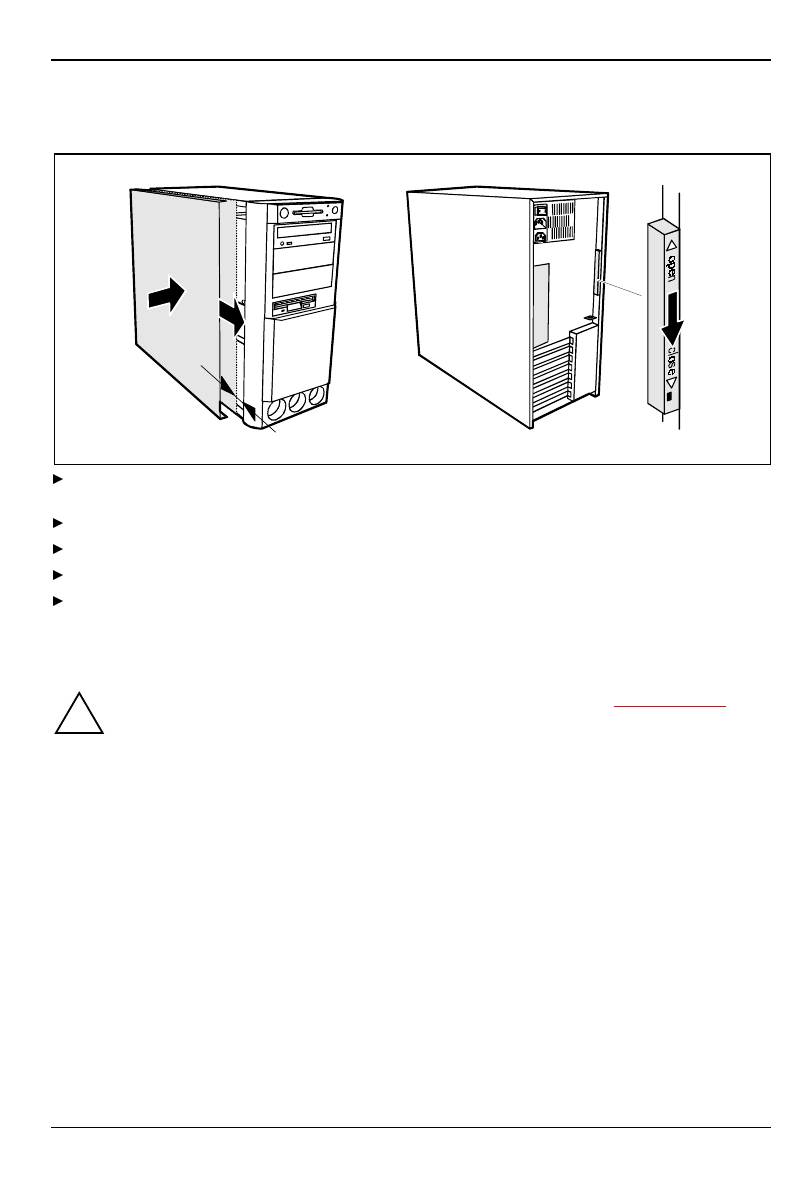
Assembling the system unit System expansions
A26361-K516-Z100-3-7619 31
Assembling the system unit
2
1
3
a
Place the side cover on the system unit in the direction of the arrow (1) so that the distance (a)
is approx. 10 mm.
Push the side cover in the direction of the arrow (2) until it engages.
Lock the side cover using the locking slide at the rear (3).
Return the system unit to its original position.
If you have disconnected cables, reconnect them at the rear.
Installing and removing a board
!Observe the notes on installing and removing boards in the chapter "Important notes".
Old ISA boards which require a -5 V power supply are not supported.
The number, position and constellation of the board slots on the system board can be found in the
technical manual for the system board. Boards may be installed when the device is shipped.
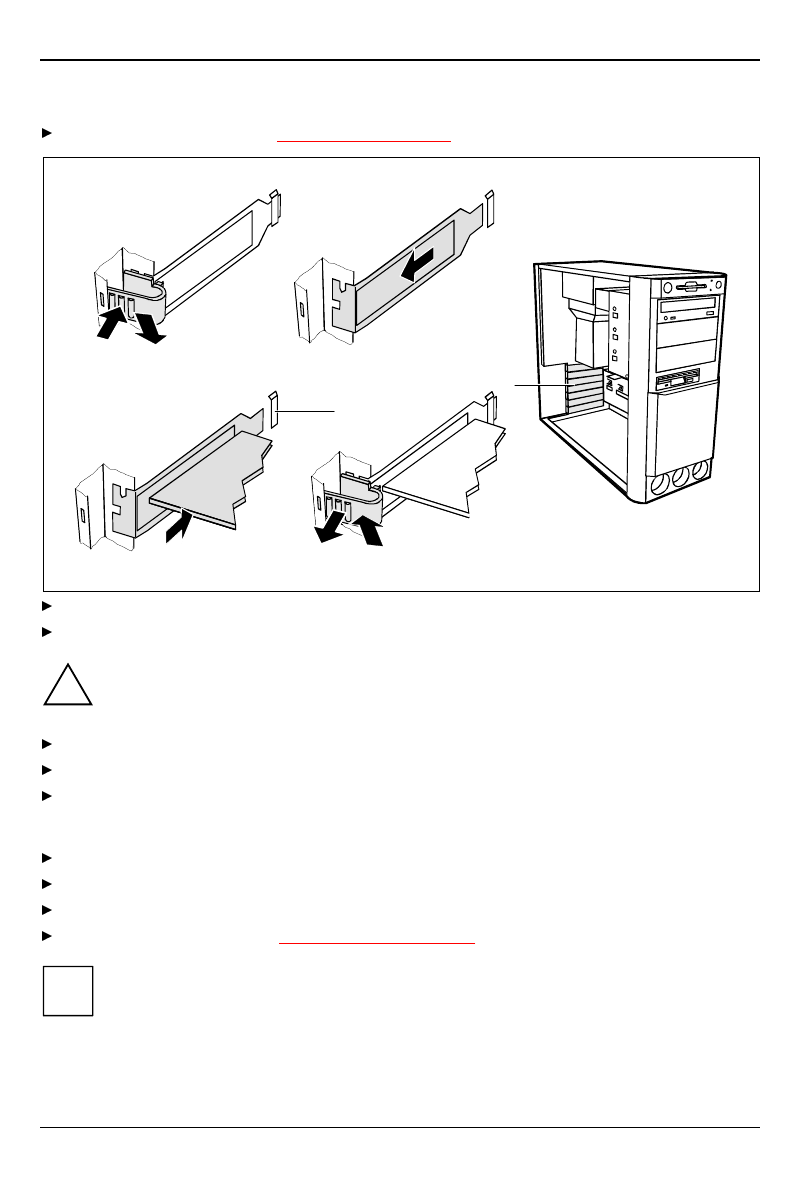
System expansions Installing and removing a board
32 A26361-K516-Z100-3-7619
Installing a board
Open the system unit (see "Opening the system unit").
3
4
a
12
5
6
Press on the clip in the direction of the arrow (1) and remove it (2).
Remove the rear slot cover plate from the slot (3).
!Do not dispose of the rear slot cover plate. For cooling, protection against fire and in order
to comply with EMC regulations, you must refit the rear slot cover plate if you remove the
board.
Take the new board out of its packaging.
Make the required settings for the board.
Push the board into the slot (4).
Ensure that the end of a long board without angle bracket fits into the corresponding guide of
the system unit. Ensure also that the point of the angle bracket slots into guide (a).
Press the board into the slot so that it engages.
Replace the clip (5) which fixes the board. Make sure that the clip engages when released (6).
If necessary, plug the lines on the board.
Close the system unit (see "Assembling the system unit").
iIf you have installed or removed a PCI board, please check in the BIOS Setup the settings
for the relevant PCI slot. If necessary, change the settings. Further information is provided
in the documentation for the PCI board.
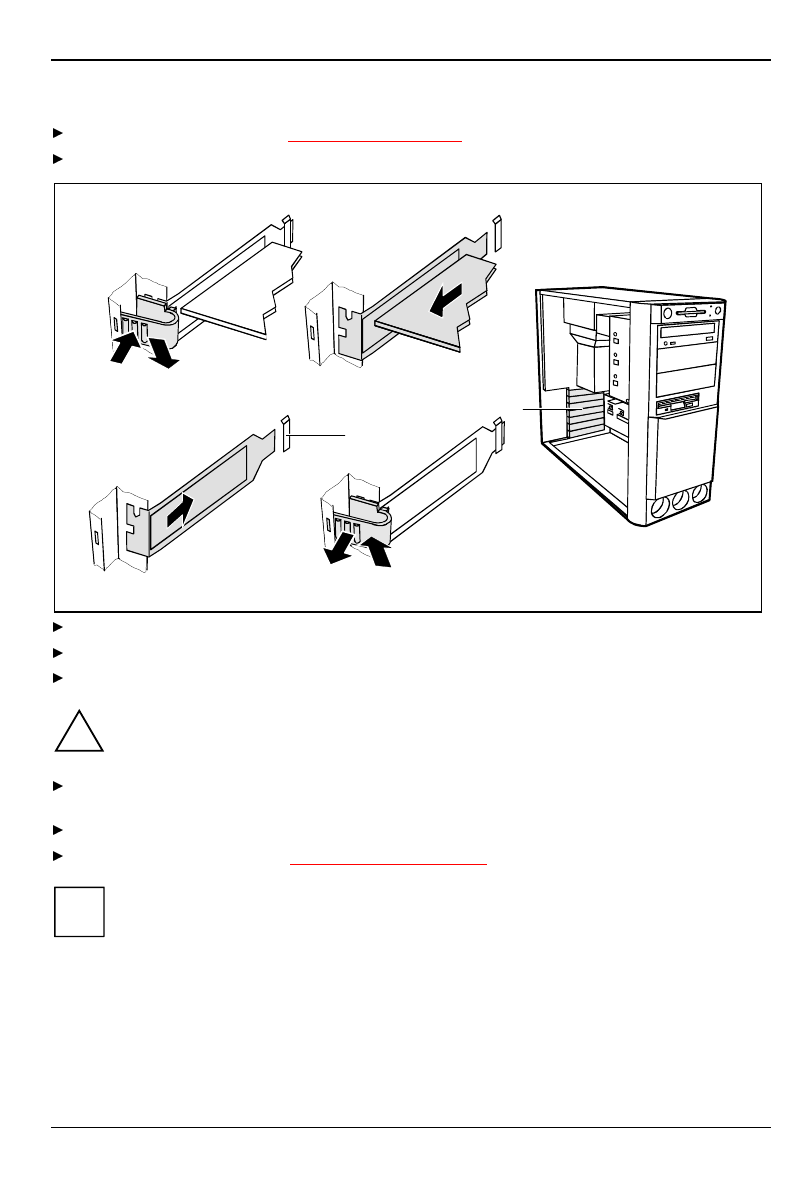
Installing and removing a board System expansions
A26361-K516-Z100-3-7619 33
Removing a board
Open the system unit (see "Opening the system unit").
Remove the lines connected to the board.
4
a
12
65
3
Press on the clip in the direction of the arrow (1) and remove it (2).
Remove the board from the system unit (3).
Place the board into an appropriate packaging.
!For cooling, protection against fire and in order to comply with EMC (electromagnetic
compatibility) regulations, you must refit the rear slot cover plate.
Push the rear slot cover plate into the slot (4). Ensure that the point of the cover engages into
the guide (a).
Replace the clip (5) which fixes the board. Make sure that the clip engages when released (6).
Close the system unit (see "Assembling the system unit").
iIf you have installed or removed a PCI board, please check in the BIOS Setup the settings
for the relevant PCI slot. If necessary, change the settings. Further information is provided
in the documentation for the PCI board.
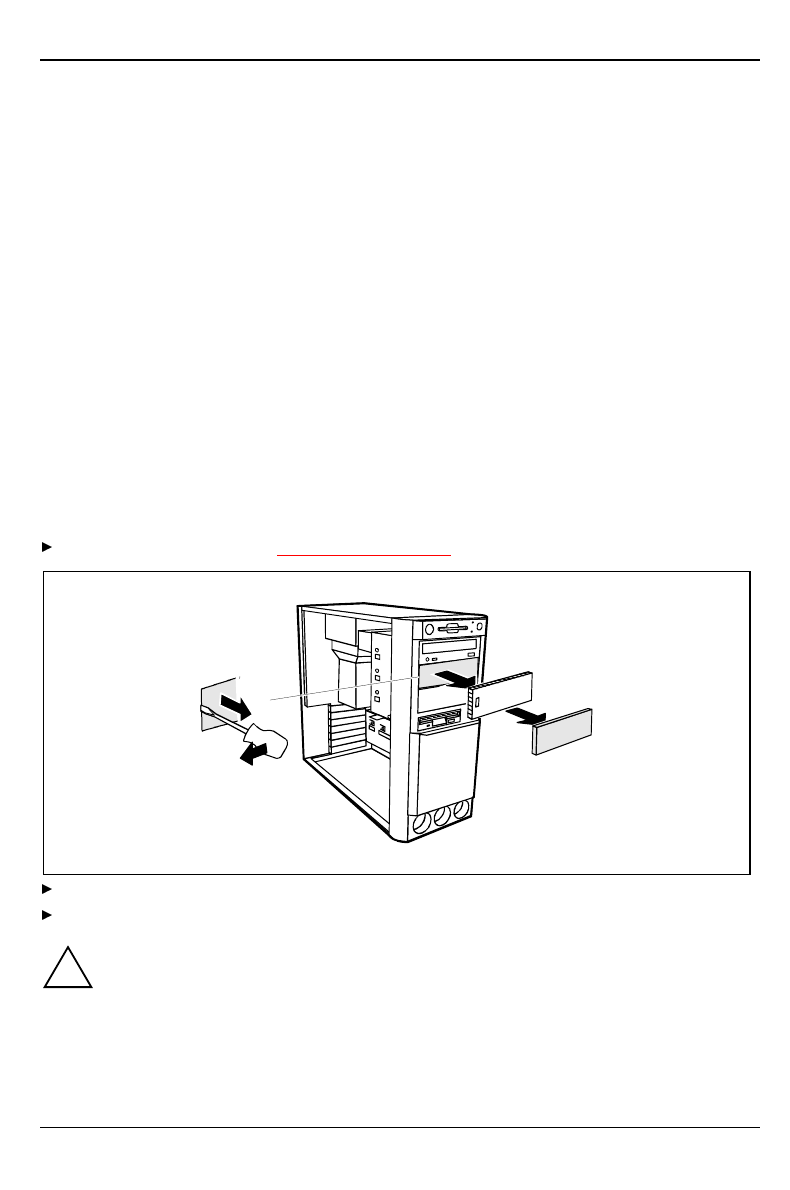
System expansions Installing and removing drives
34 A26361-K516-Z100-3-7619
Installing and removing drives
The system unit houses a total of four accessible drives (three 5 1/4-inch drives and one 3 1/2-inch
drive) and two non-accessible half-height (Slimline) drives .
IDE drives
By default four IDE drives are supported. Ideally hard disks are connected to IDE port 1, and
accessible drives, for example CD-ROMs, to IDE port 2 (see also the Technical Manual for the
system board).
SCSI drives
If you want to install an SCSI drive, you require an SCSI controller and an SCSI cable. Note that:
• not every SCSI controller is suitable for operating SCSI hard disks
• each SCSI device must be assigned its own SCSI-ID
• The SCSI cable must always be terminated at the end, either by a drive or by a terminating
resistor on the cable. The terminating resistors of all other SCSI devices attached must not be
activated or connected.
• Depending on the SCSI technology (UW, U2W), an adapter may be required for connecting the
SCSI drives with a 50-pin connector.
Installing an accessible drive
Open the system unit (see "Opening the system unit").
A
B
1
2
Pry the plastic drive cover (A) out of the front cover.
Pry the shielding plate (B) on left-hand side out of the bay.
!Do not throw away the covers. If you remove the drive again later, you will have to
reinstall the covers.
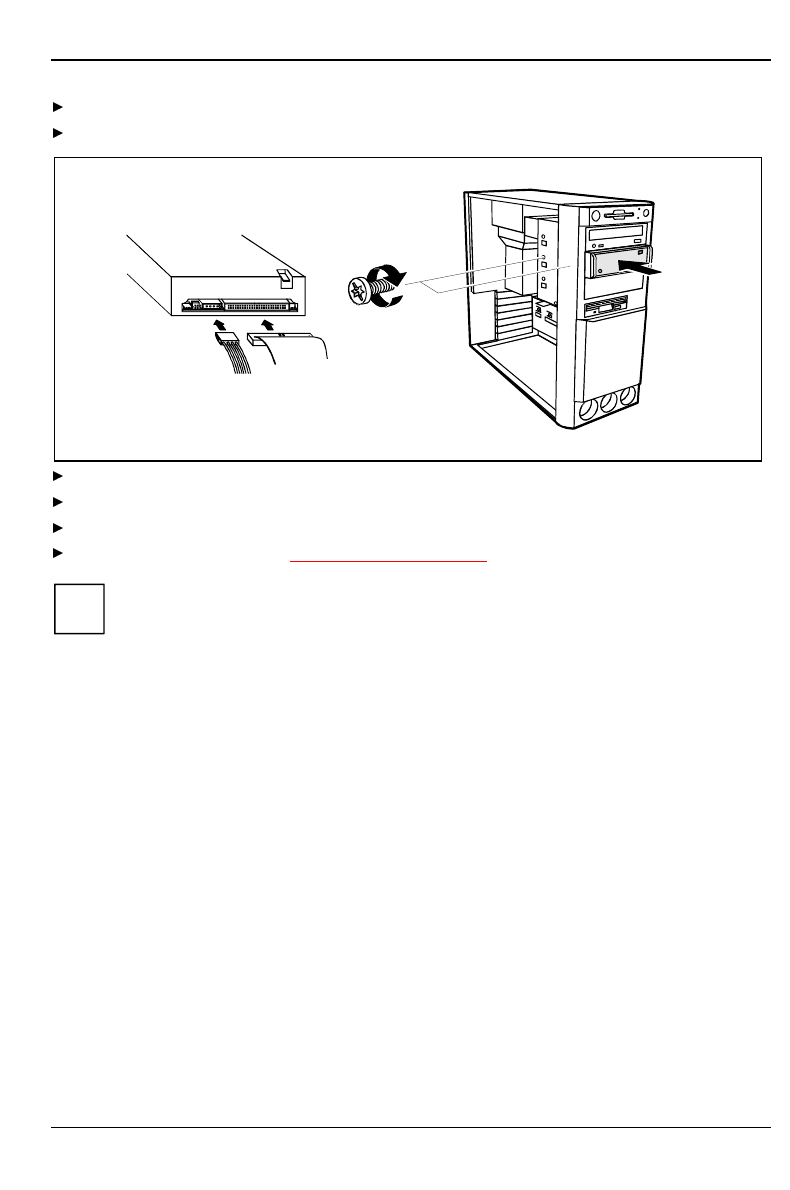
Installing and removing drives System expansions
A26361-K516-Z100-3-7619 35
Take the new drive out of its packaging.
Make the required settings on the drive (if necessary, on installed drives as well).
3
1
2
Slide the drive into the system unit (1).
Plug the connectors of the data cable and the power supply cable into the drive (2).
Fasten the drive with the screws (3).
Close the system unit (see "Assembling the system unit").
iIf necessary, you must adapt the entry for the drive in the Setup menu.
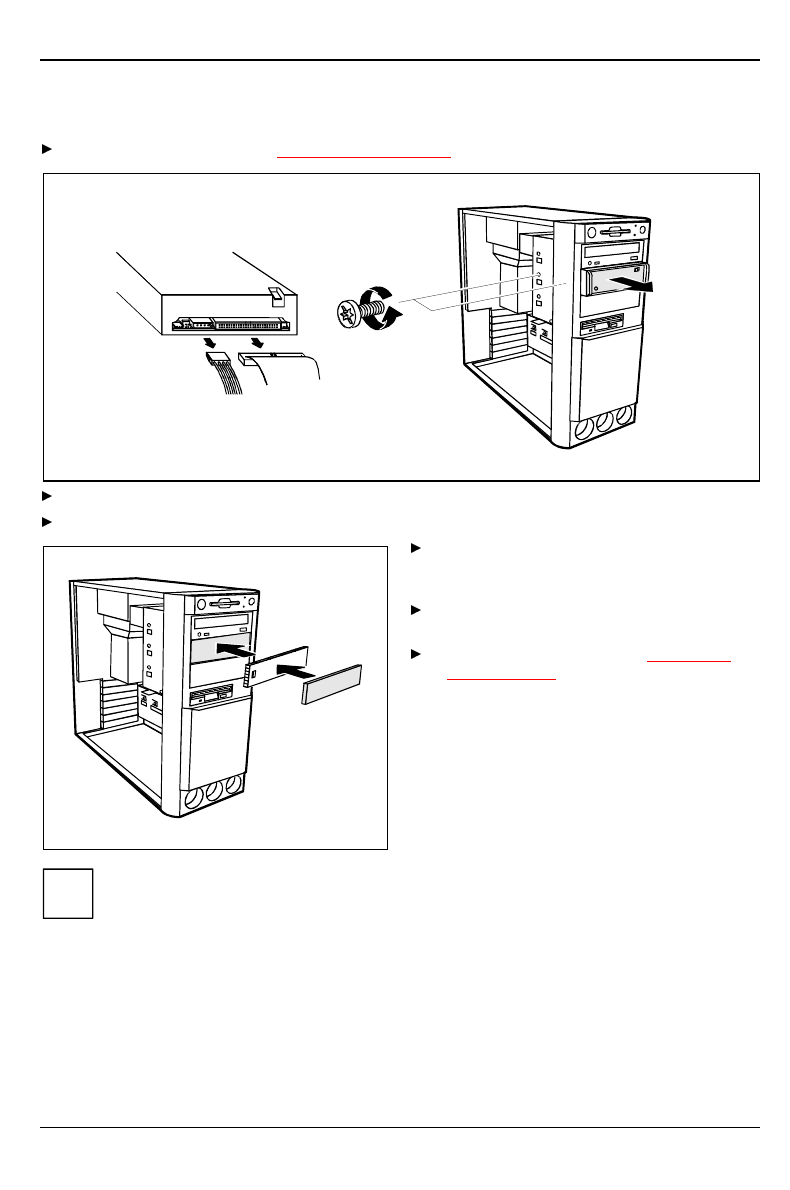
System expansions Installing and removing drives
36 A26361-K516-Z100-3-7619
Removing an accessible drive
Open the system unit (see "Opening the system unit").
2
1
3
Pull the data and the power supply connectors from the desired drive (1).
Remove the screws (2) and take the drive out of the system unit (3).
A
B
Insert the shielding plate (B) on the right-
hand side on the installation bay and press
it in.
Press the plastic drive cover (A) into the
front panel until it snaps in place.
Close the system unit (see "Assembling
the system unit").
iIf necessary, you must adapt the entry for the drive in the Setup menu.
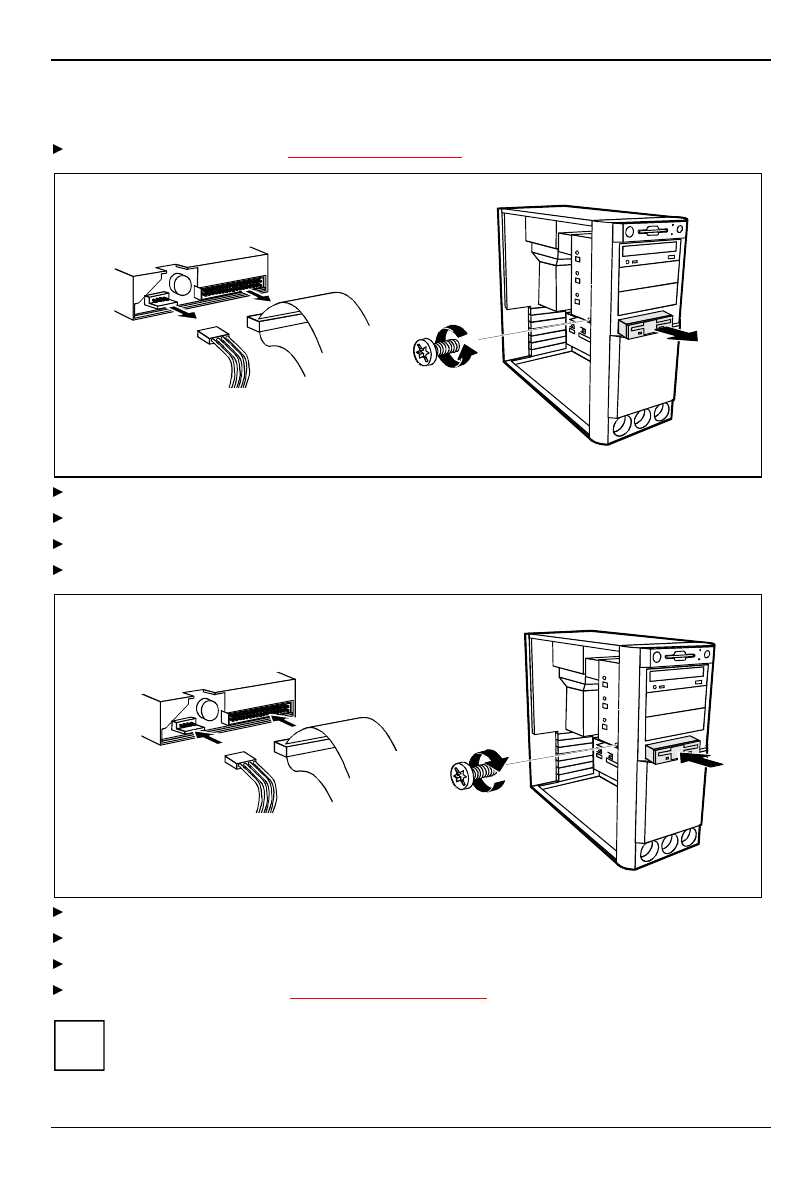
Installing and removing drives System expansions
A26361-K516-Z100-3-7619 37
Changing the floppy disk drive
Open the system unit (see "Opening the system unit").
2
3
1
Pull the data and the power supply connectors from the floppy disk drive (1).
Remove the screw (2).
Take the drive out of the system unit (3).
Take the new floppy disk drive out of its packaging.
3
1
2
Slide the drive into the system unit (1).
Plug the data and the power supply connectors into the floppy disk drive (2).
Fasten the drive with the screw (3).
Close the system unit (see "Assembling the system unit").
iIf necessary, you must adapt the entry for the drive in the Setup menu.
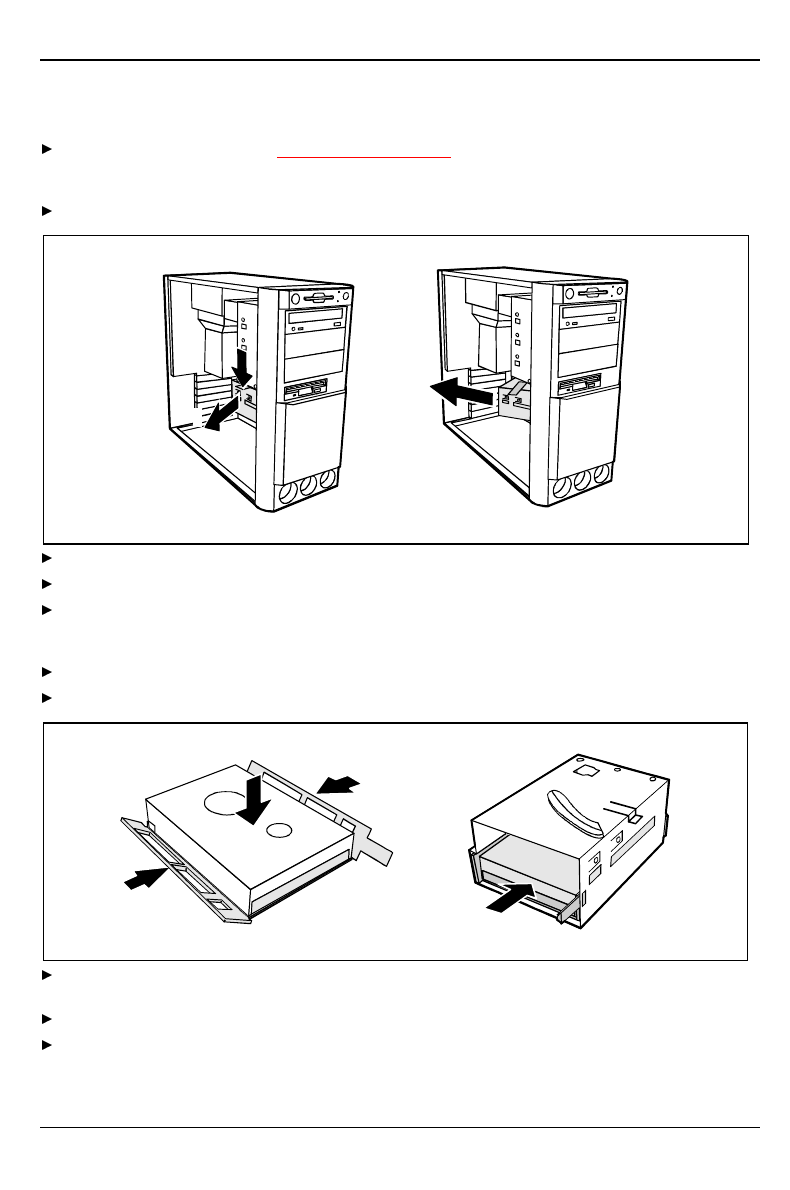
System expansions Installing and removing drives
38 A26361-K516-Z100-3-7619
Installing or removing the hard disk drive
Open the system unit (see "Opening the system unit").
Removing the hard disk carrier
Pull the data and power supply connectors from the hard disk drive or the hard disk drives.
3
2
1
Press the unlocking device in the direction of the arrow (1).
Swivel the drive carrier in the direction of the arrow (2).
Remove the drive carrier in direction of the arrow (3).
Installing the first hard disk drive
Take the new hard disk drive out of its packaging.
Make the required settings (e.g. master-slave settings) on the drive.
3
2
2
1
Insert the hard disk drive into the plastic bracket (1). The drive must engage in the plastic
nipple.
Fold the plastic bracket in the direction of the arrow (2) on the hard disk drive.
Push the hard disk drive into the drive bracket until the plastic bracket engages (3).
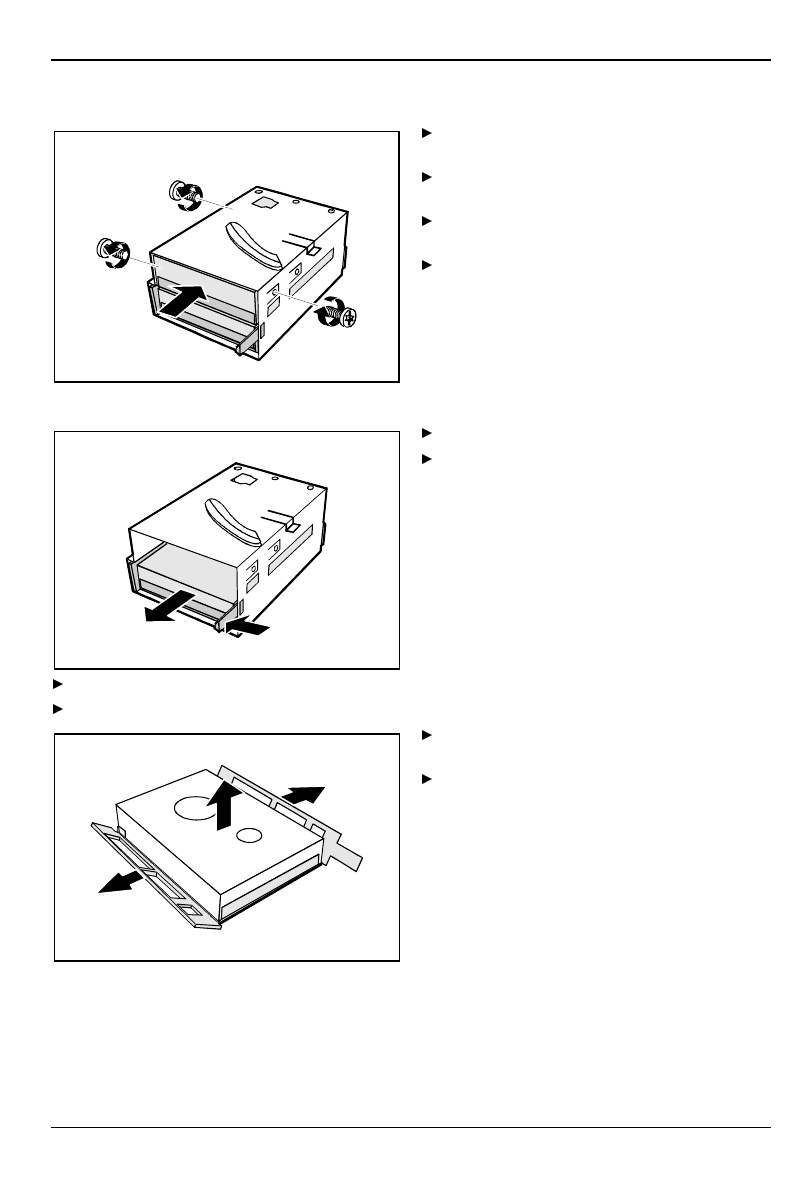
Installing and removing drives System expansions
A26361-K516-Z100-3-7619 39
Installing the second hard disk drive
2
2
2
1
Take the new hard disk drive out of its
packaging.
Make the required settings (e.g.
master/slave, stand alone) on the drives.
Slide the hard disk drive into the drive
carrier (1).
Fasten the drive with the screws (2).
Removing the first hard disk drive
21
Lightly press on the clip (1).
Pull the hard disk drive out of the
carrier (2).
Press on the clip (1).
Pull the hard disk drive out of the carrier (2).
1
1
2
Fold the plastic bracket in the direction of
the arrow (1).
Remove the hard disk drive (2).
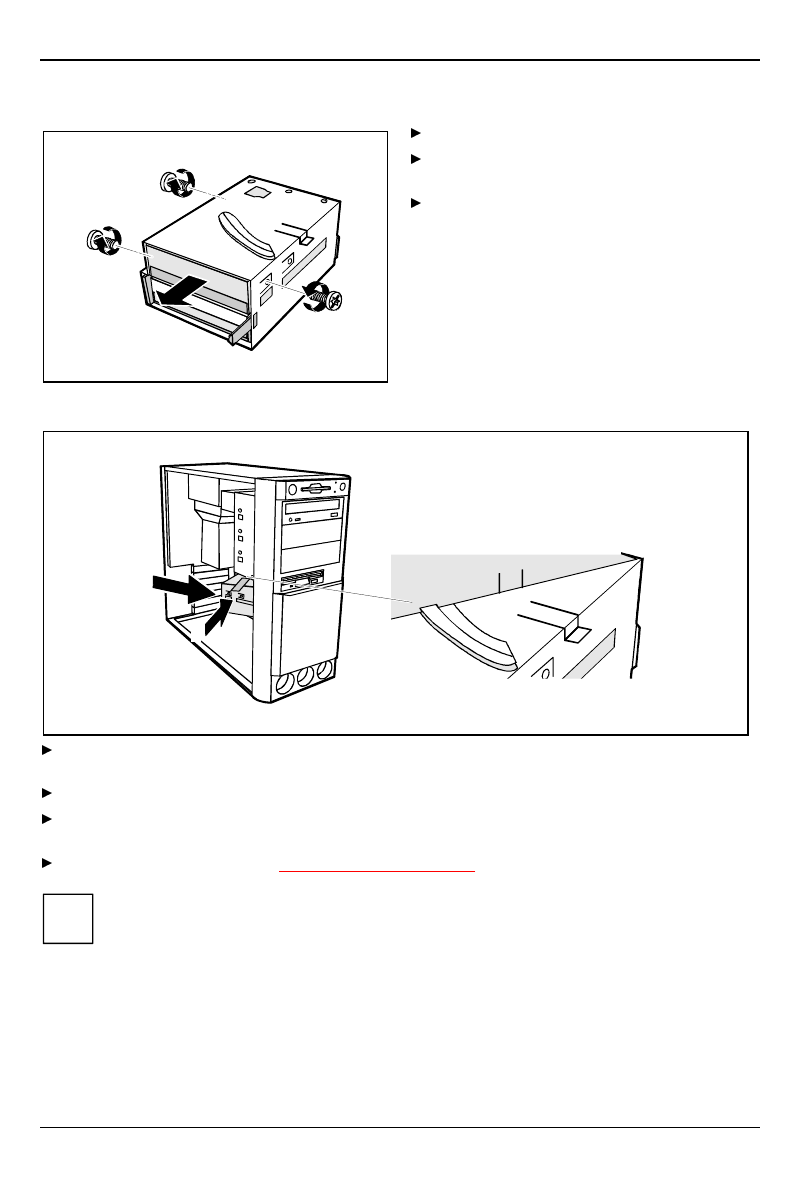
System expansions Installing and removing drives
40 A26361-K516-Z100-3-7619
Removing the second hard disk drive
1
1
1
2
Remove the screws (1).
Pull the hard disk drive out of the
carrier (2).
Make the required settings on the
remaining hard disk drive
(e.g. stand alone).
Installing the hard disk carrier
1
2
Plug the data and the power supply connectors into the hard disk drive or into the hard disk
drives.
Push the drive carrier into the system unit in the direction of the arrow (1).
Swivel the drive carrier in the direction of the arrow (2) until it clicks into position. Please ensure
that the guide rail is in the groove.
Close the system unit (see "Assembling the system unit").
iIf necessary, you must adapt the entry for the drive in the Setup menu.
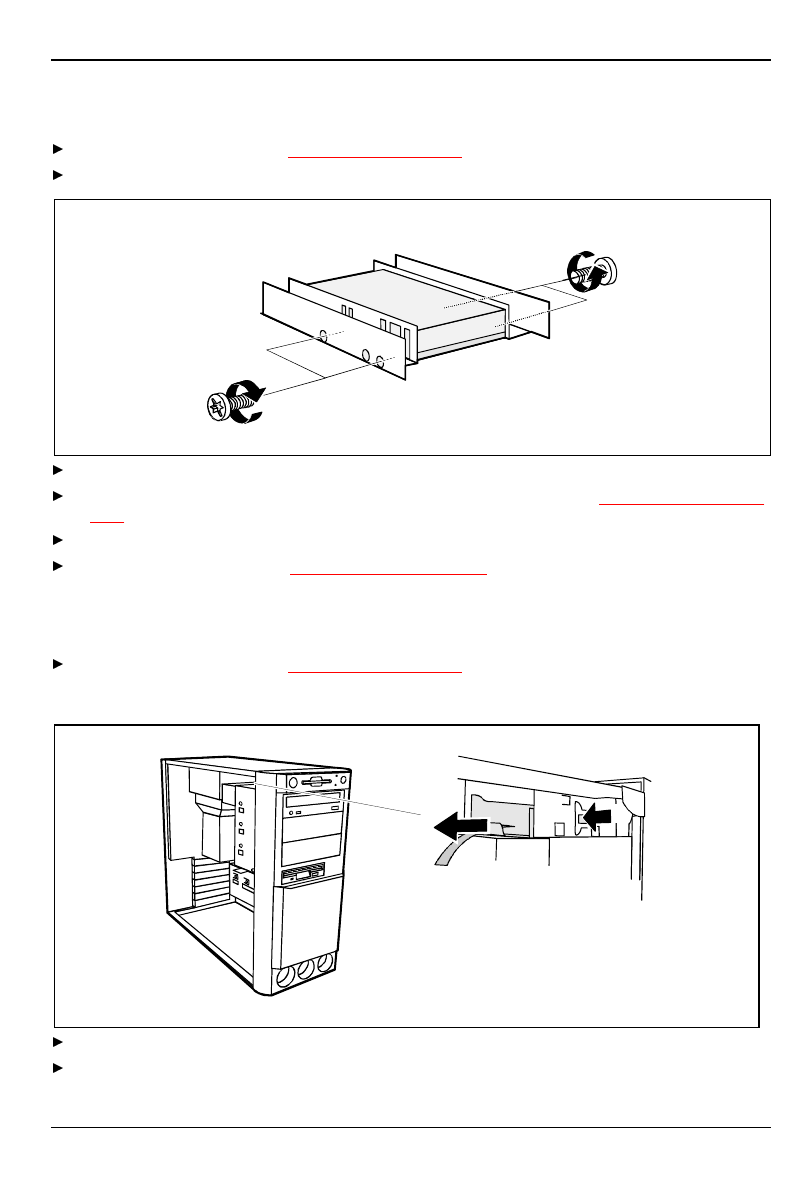
Installing/removing a chipcard reader System expansions
A26361-K516-Z100-3-7619 41
Installing a hard disk drive in the front bay
Open the system unit (see "Opening the system unit").
Make the required settings (e.g. master-slave) on the hard disk drives.
Fasten the drive with the four screws.
Install the installation frame with the drive in the desired front bay (see "Installing an accessible
drive").
Close the slot with the panel. Ensure that the cover engages.
Close the system unit (see "Assembling the system unit").
Installing/removing a chipcard reader
Open the system unit (see "Opening the system unit").
Removing the hard disk carrier
1
2
Press on the clip (1).
Pull the carrier for the chipcard reader out of the system unit in the direction of the arrow (2).
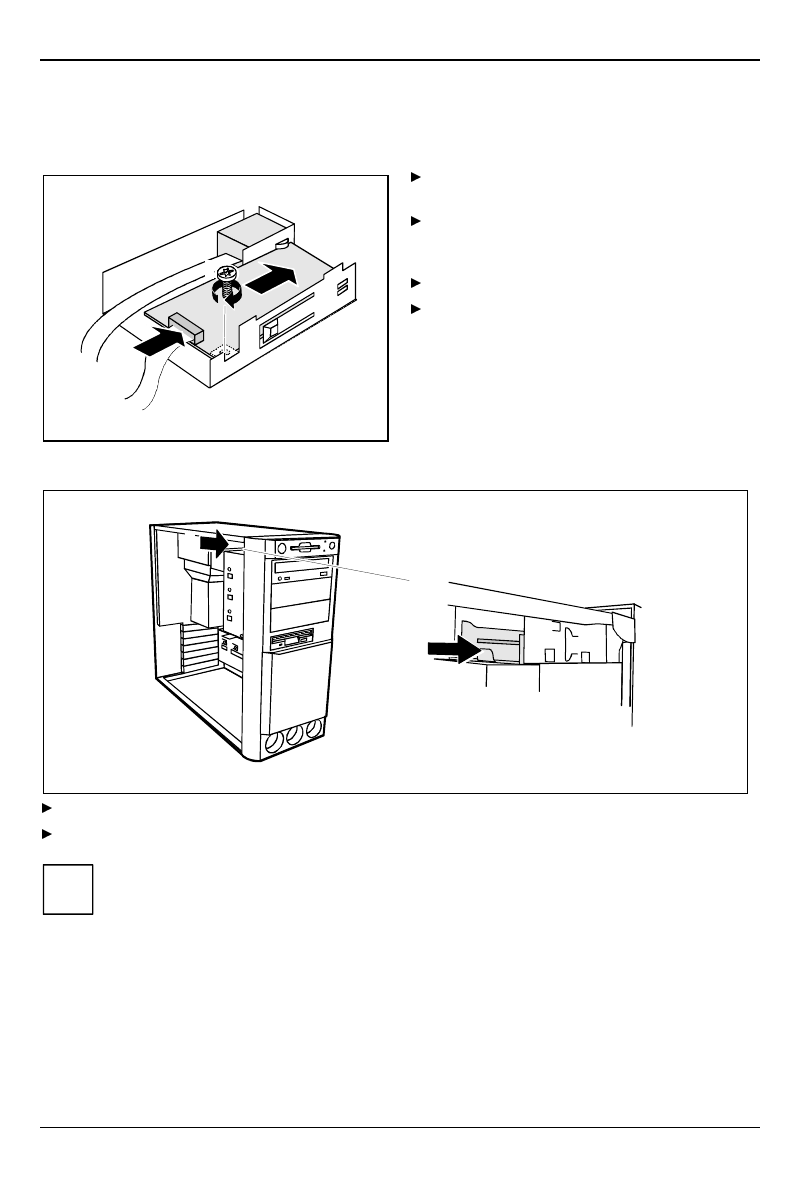
System expansions Installing/removing a chipcard reader
42 A26361-K516-Z100-3-7619
Installing a chipcard reader
Use the carrier from your device even if an additional carrier may be enclosed with the chipcard
reader.
1
2
3
Remove the protector panel at the front of
the carrier.
Push the chipcard reader board into the
guide rail of the carrier (1) with the
component's side upwards.
Fix the board with the screw (2).
Fix the cable on the chipcard reader (3)
and on the connector for the chipcard
reader on the system board (see the
Technical Manual of the system board).
Installing the hard disk carrier
2
1
Lift the chipcard reader into the system unit (1).
Push the chipcard reader into the carrier until it clicks into position (2).
iWith the chipcard reader connected, no devices may be connected to serial port 2.
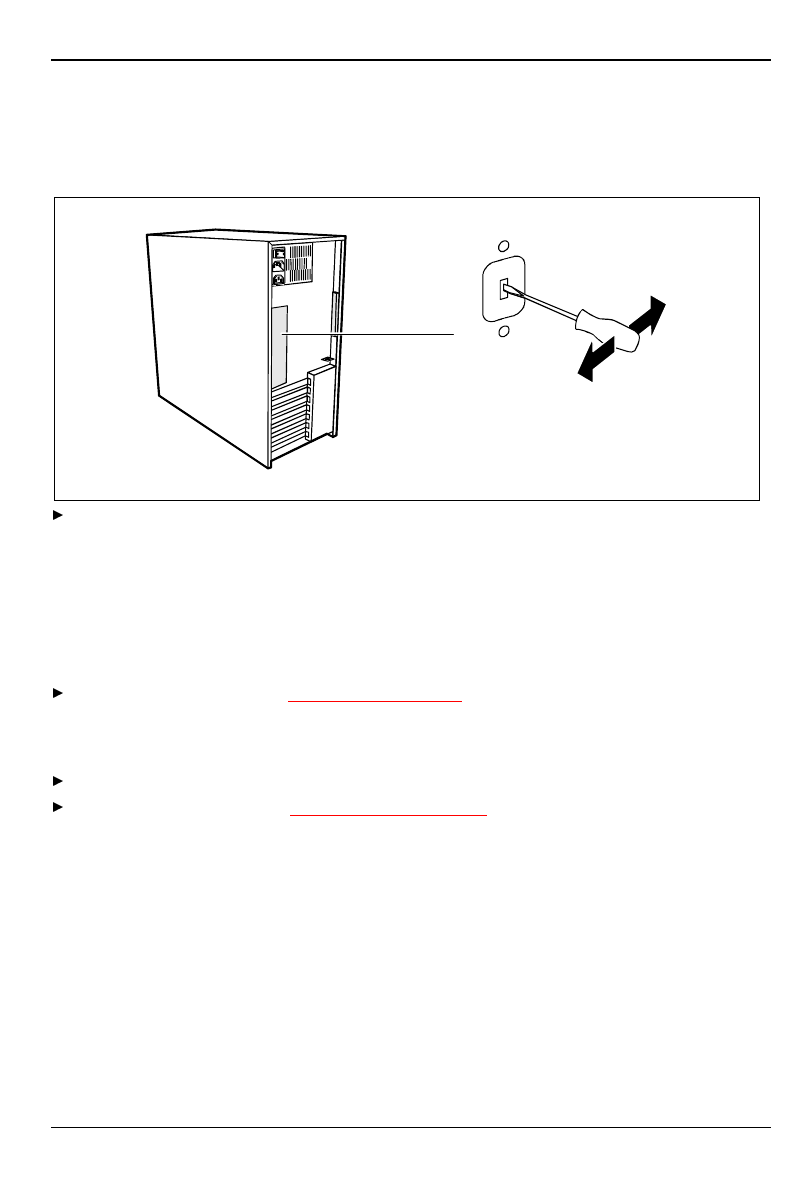
Installation opening for 2nd serial port System expansions
A26361-K516-Z100-3-7619 43
Installation opening for 2nd serial port
An installation opening for the 2nd serial port is provided on the back of the casing. As a result, this
means no board slot is occupied.
Insert a screwdriver into the opening and break out the pre-stamped installation opening by
moving back and forth.
Extensions on the system board
Details of how and if you can upgrade the main memory or the processor of your PC are provided in
the Technical Manual for the system board. Below the necessary steps are described to enable you
to work on the system board.
Open the system unit (see "Opening the system unit").
Upgrading main memory
Upgrade the memory as it is described in the Technical Manual for the system board.
Close the system unit (see "Assembling the system unit").
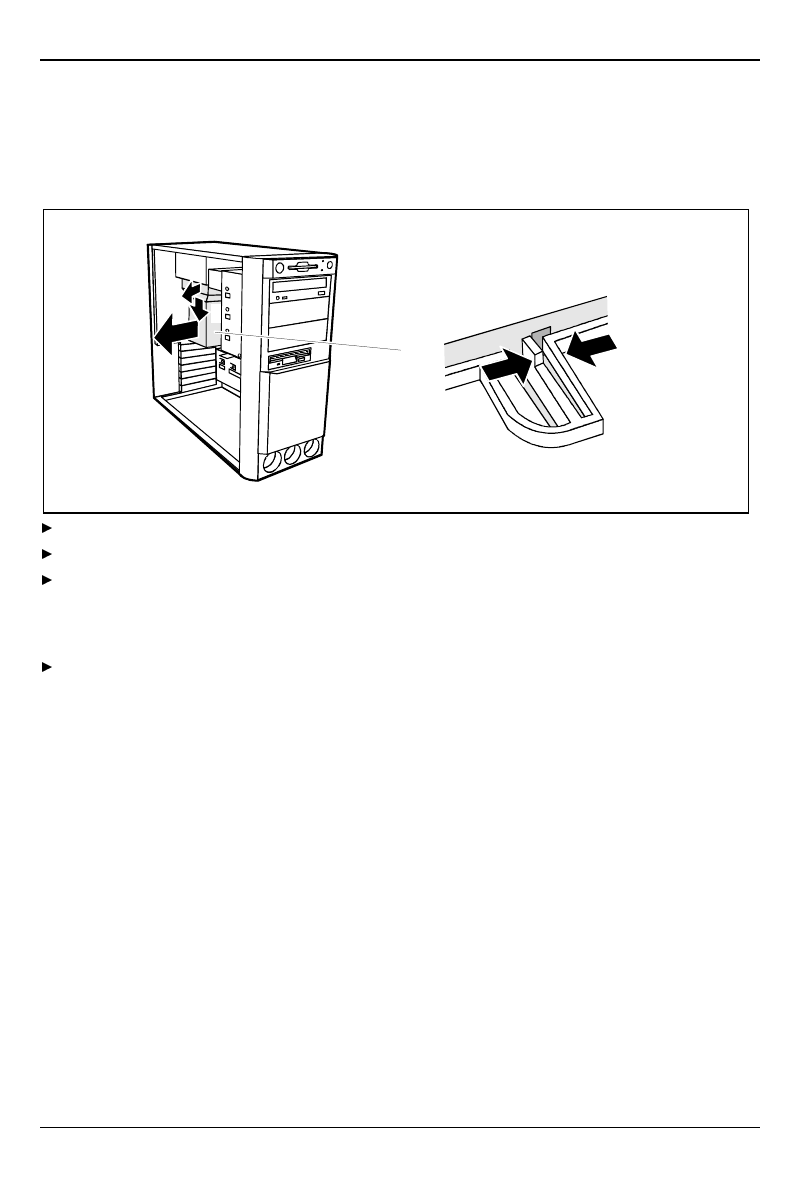
System expansions Extensions on the system board
44 A26361-K516-Z100-3-7619
Replacing processor and lithium battery
To replace the processor and the lithium battery, you must remove the ventilation duct.
Removing ventilation duct
23
4
11
Press the clip together (1).
Lift the ventilation duct slightly (2) and guide the ventilation duct out of the guide holes (3).
Remove the ventilation duct from the unit (4).
You have free access to the locations.
Replacing processor
Make the desired expansions (see the Technical Manual for the system board).
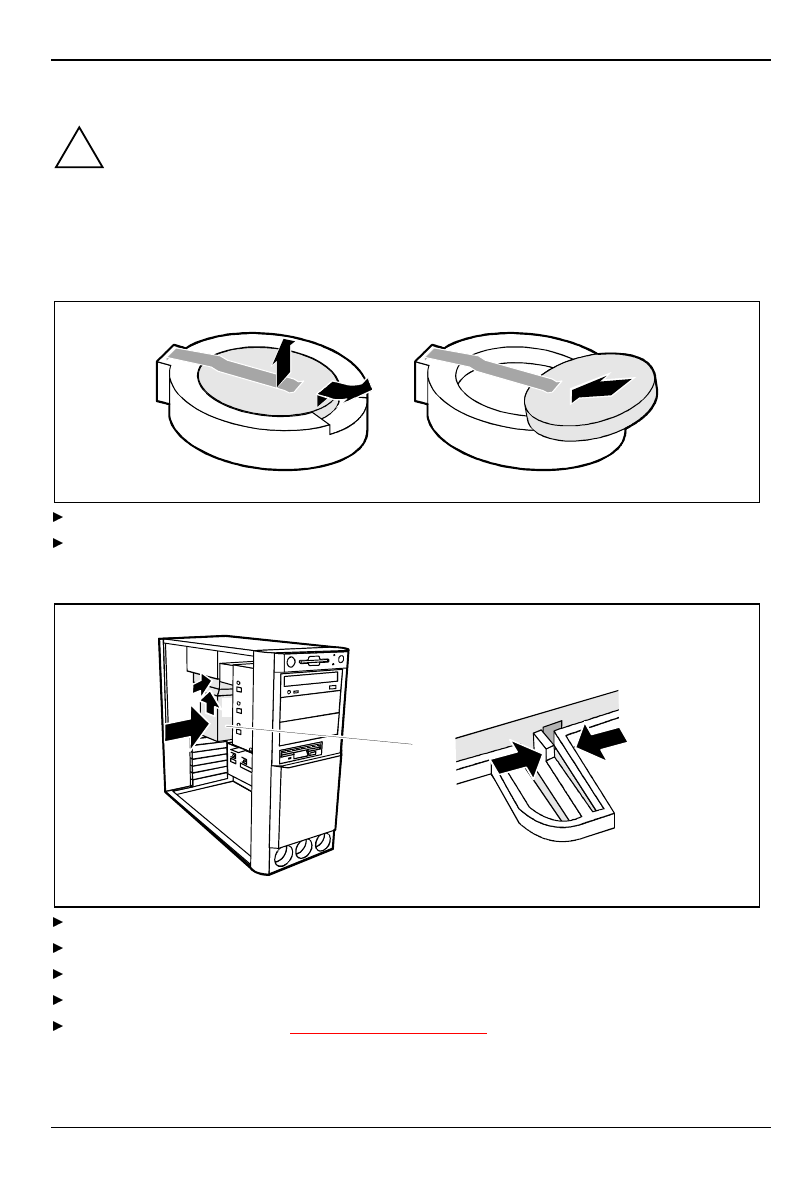
Extensions on the system board System expansions
A26361-K516-Z100-3-7619 45
Replacing lithium battery
!Incorrect replacement of the lithium battery may lead to a risk of explosion.
The lithium battery may be replaced only with an identical battery or with a type
recommended by the manufacturer.
Do not throw lithium batteries into the trashcan. It must be disposed of in accordance with
local regulations concerning special waste.
Make sure that you insert the battery the right way round. The plus pole must be on the
top!
1
23
+
++
+
Lift the contact (1) a few millimeters and remove the battery from its socket (2).
Insert a new lithium battery of the same type in the socket (3).
Installing ventilation duct
43
1
22
Lift the ventilation duct into the unit (1)
Press the clip together (2).
Insert the ventilation duct into the guide holes (3).
Press the ventilation duct downward until the clip engages (4).
Close the system unit (see "Assembling the system unit").


A26361-K516-Z100-3-7619 47
Technical data
Electrical data
Regulations complied with: EN 60950 / VDE 0805
UL 1950
CSA 22.2 No.950
Protection class: I
Rated voltage range: (selectable) 100 V to 125 V / 200 V to 240 V
Frequency: 50 Hz - 60 Hz
Max. rated current
• System unit with monitor socket:
• Monitor socket (output)
100 V - 125 V / 7.0 A
200 V - 240 V / 3.5 A
100 V - 125 V / 3.0 A
200 V - 240 V / 1.5 A
Typical power draw in operation:
Power draw in energy saving mode:
Power draw in the 'ready' status
< 35 W *)
< 28 W *)
< 3 W *)
Dimensions
Width/Depth/Height:
Weight: 205 mm/500 mm/443 mm
ca. 13 kg (127.53 N) in basic configuration
Environmental conditions
Environment class (3K2)
Environment class (2K2) DIN IEC 721 part 3-3
DIN IEC 721 part 3-2
Temperature:
• Operating (3K2)
• Transport (2K2) 15 °C .... 35 °C
-25 °C .... 60 °C
Condensation in operating must be avoided.
Clearance required to ensure adequate ventilation:
• left-hand side
• front
• rear
min. 200 mm
min. 200 mm
min. 200 mm
*) These values only apply for a SCENIC 800 with the configuration below. When additional
components are incorporated, the power consumption in energy saving mode may exceed the
requirements for the environment symbol ("Blue Angel") (30 W).
Processor (512 Kbyte cache):
Main memory:
Floppy disk drive:
Hard disk drive:
CD-ROM drive:
Graphics:
LAN:
Pentium II MMX at 450 MHz
192 Mbytes
1.44 Mbytes
6.4 Gbyte
32fold
Matrox MGA G100 AGP
10/100 MBit Ethernet Controller onboard


A26361-K516-Z100-3-7619 49
Index
2
2nd serial port
installation opening 43
A
Accessible drive
installing 34
removing 36
Accumulator, disposal 4
Activating, security measures 23
Alphanumeric keypad 20
Alt Gr key 21
Anti-theft protection 24
Assembling, PC 31
Audio input 11
Audio output 11
B
Battery 44, 45
disposal 4
BIOS Setup 23
security functions 24
Board 4
installing 31
removing 31
C
Cable
connecting 10
disconnecting 10
Cabling, PC 10
Calculator keypad 20
Casing
assembling 31
opening 30
Casing lock 15
CD-ROM drive
indicator 19
installing 34
manual 28
removing 36
CE certificate 5
Changing
floppy disk drive 37
hard disk drive 38
lithium battery 44, 45
Checking, rated voltage 14
Chipcard reader 11

Index
50 A26361-K516-Z100-3-7619
indicator 19
Installing/removing 41
Class B Compliance Statement 5
Cleaning 8
Clearance 47
Closing, system unit 31
Configuration, BIOS-Setup 23
Connecting
cables 10
devices 10
keyboard 12
monitor 13
mouse 12
parallel port 12
power voltage 14
serial port 12
Connecting to power voltage 14
Contents of delivery 9
Control key 21
Courier 1
Ctrl key 21
Ctrl+Alt+Del 21
Cursor control keys 20
D
Dark screen 26
Data protection 23
Data, technical 47
Date, not correct 27
Devices
connecting 10
interface 11
Dimensions 47
Diskette 22
cannot be read or written 27
write-protection 22
Disposal 4
Drive 34
Drive cover 15
E
Electrical data 47
Electromagnetic compatibility 5
Energy saving 4
Enter key 21
Environmental conditions 47
Environmental data 47
Ergonomic, video workstation 10
Errordate 27
floppy 27
mouse 27
screen 26
system unit 25

Index
A26361-K516-Z100-3-7619 51
time 27
Error message 27
ESD 4
Euro key 21
Expansion 29
External devices
connecting 10
ports 11
F
FCC statement 5
First time, switching on 17
Flashing power-on indicator 20
Floppy disk drive
changing 37
indicator 19
removing 36
Function keys 20
G
Game port 11
Green, power-on indicator 20
Guarantee coupon booklet 9
H
Hard disk drive
indicator 19
replacing 38
I
IDE drives 34
Important notes 3
Indicator
power-on indicator fails to light 25
remains blank 26
Indicators, system unit 19
Installation opening
2nd serial port 43
Installation, new Software 25
Installing
accessible drive 34
board 31
chipcard reader 41
hard disk carrier 40
hard disk drive 38, 39
ventilation duct 45
Insufficient memory 28
Interfaces 11
Italics 1
K
Kensington Lock 24
Key combination 21

Index
52 A26361-K516-Z100-3-7619
Keyboard 20
cleaning 8
connecting 12
Keyboard port 11
Keys 21
L
LAN-port 11
Lead-sealing 24
Line in 11
Line out 11
Lithium battery 43
replacing 44, 45
Lock 15
Locking, PC 15
M
Main memory 43
Main switch 16
Manuals, further 28
Manufacturer’s notes 4
Memory, upgrading 43
Menu key 21
Message indicator 19
Microphone jack 11
Monitor
cleaning 8
connecting 13
transporting 7
Monitor port 11
Mouse
cleaning 8
connecting 12
error 27
Mouse port 11
N
New Installation, Software 25
No screen display 26
Not enough memory 28
Notational conventions 1
Noteboards 4
CE certificate 5
disposal 4
energy saving 4
important 3
manufacturer 4
power cord selecction 6
safety 3
Num Lock key 21
Numeric keypad 20

Index
A26361-K516-Z100-3-7619 53
O
ON/OFF switch 16, 21
Opening
system unit 30
Operation 9
Orange, power-on indicator 20
Other manuals 28
Overview
PC 1
preparing for use 9
P
Packing material 9
Parallel port 11
connecting devices 12
PC cabling 10
cannot boot 25
cleaning 8
closing 31
connecting 10
connecting to power voltage 14
indicators 19
locking 15
opening 30
ports 11
setting up 10
switching off 16, 18
switching on 16, 18
switching on for the first time 17
transporting 7
unlocking 15
Ports, external devices 11
Power cord selecction 6
Power management 28
Power-on indicator 16, 20
dark 25
POWERSAV.SCR 4
Preparation for use 9
overview 9
Problems 25
Processor 43
Property protection 23
PS/2 mouse port 11
Q
Quiet Boot 26
R
Rated voltage
setting 14
Ready-to-operate 16
Recycling 4
Reinstallation of the hard disk 27

Index
54 A26361-K516-Z100-3-7619
Reinstalling, hard disk contents 27
Removing
accessible drive 36
board 31
chipcard reader 41
hard disk carrier 38
hard disk drive 39, 40
ventilation duct 44
Replacing
board 31
hard disk drive 38
lithium battery 44, 45
Return key 21
S
Safety 3
Screen
blank 17, 18, 26
Screen blanking 4
SCSI drive 34
Security function 24
Security functions
casing lock 23
Chipcard 23
MS-Windows 23
Security measures 23
Select, power cord 6
Serial interface 11
Serial port
connecting devices 12
Setting
rated voltage 14
Settings
BIOS Setup 23
Setup, see BIOS Setup
Shift key 21
Soft Power Off 18
Software, New Installation 25
Start key 21
Streamer
installing 34
removing 36
Summer time 27
Surface 47
Switching off, PC 16, 18
Switching on, PC 16, 18
Symbols, explanation of 1
System board
extensions 43
System expansion 29
System settings, BIOS Setup 23
System unit
opening 30
System unit, see PC

Index
A26361-K516-Z100-3-7619 55
T
Technical data 47
Time, not correct 27
Tips 25, 28
Transport 7
Trouble
floppy 27
mouse 27
screen 26
system unit 25
Troubleshooting 25
U
Unlocking, PC 15
Unpacking 9
Upgrading, memory 43
USB, Universal Serial Bus 11
V
Ventilation area 47
Ventilation duct
installing 45
removing 44
VESA (DPMS) 4
Video workstation 10
W
Warm boot 21
Winter time 27
Write protection, floppy 22


A26361-K516-Z100-3-7619
Contents
Introduction..................................................................................................................................... 1
Notational conventions...................................................................................................................... 1
Important notes............................................................................................................................... 3
Safety ............................................................................................................................................... 3
Notes on installing and removing boards................................................................................... 3
Manufacturer's notes......................................................................................................................... 4
Energy saving ........................................................................................................................... 4
Disposal and recycling .............................................................................................................. 4
CE certificate ............................................................................................................................ 5
FCC Class B Compliance Statement ........................................................................................ 5
Power cord selection................................................................................................................. 6
Transporting the PC.......................................................................................................................... 7
Cleaning the PC................................................................................................................................8
Preparation for use and operation................................................................................................. 9
Unpacking and checking the delivery................................................................................................ 9
Preparing the PC for use................................................................................................................... 9
Setting up the PC............................................................................................................................ 10
Connecting devices......................................................................................................................... 10
Ports for external devices........................................................................................................ 11
Connecting the keyboard ........................................................................................................ 12
Connecting the mouse ............................................................................................................ 12
Connecting devices with serial or parallel port......................................................................... 12
Connecting the monitor to the line voltage .............................................................................. 13
Connecting the PC to the line voltage ............................................................................................. 14
Unlocking/locking the system unit................................................................................................... 15
Switching the PC on and off............................................................................................................ 16
Switching on the PC for the first time ...................................................................................... 17
Switching on the PC................................................................................................................ 18
Switching off the PC................................................................................................................ 18
Indicators on the system unit .......................................................................................................... 19
Keyboard ........................................................................................................................................ 20
Important keys and key combinations ..................................................................................... 21
Working with floppy disks................................................................................................................ 22
Settings in BIOS Setup ................................................................................................................... 23
Property and data protection........................................................................................................... 23
Locking the system unit mechanically..................................................................................... 23
Access authorization via chipcard........................................................................................... 23
Security functions under Windows .......................................................................................... 23
Theft protection and lead sealing ............................................................................................ 24
BIOS Setup security functions ................................................................................................ 24
Troubleshooting and tips............................................................................................................. 25
Installing new software.................................................................................................................... 25
Power-on indicator remains dark after you have switched on your device....................................... 25
The screen stays blank................................................................................................................... 26
No mouse pointer displayed on the screen ..................................................................................... 27
The floppy disk cannot be read or written........................................................................................ 27
Time and/or date is not correct ....................................................................................................... 27
Error messages on the screen ........................................................................................................ 27
Restoring the hard disk contents..................................................................................................... 27
Tips 28

Contents
A26361-K516-Z100-3-7619
System expansions.......................................................................................................................29
Opening the system unit..................................................................................................................30
Assembling the system unit.............................................................................................................31
Installing and removing a board.......................................................................................................31
Installing and removing drives ......................................................................................................... 34
Installing an accessible drive................................................................................................... 34
Removing an accessible drive.................................................................................................36
Changing the floppy disk drive.................................................................................................37
Installing or removing the hard disk drive.................................................................................38
Installing a hard disk drive in the front bay...............................................................................41
Installing/removing a chipcard reader..............................................................................................41
Installation opening for 2nd serial port...............................................................................................43
Extensions on the system board......................................................................................................43
Upgrading main memory .........................................................................................................43
Replacing processor and lithium battery..................................................................................44
Technical data ...............................................................................................................................47
Index...............................................................................................................................................49

A26361-K516-Z100-3-7619

A26361-K516-Z100-3-7619
A26361-K516-Z100-3-7619
SCENIC 800
Operating Manual
March 1999 edition
Microsoft, MS, MS-DOS, Windows and Windows NT are Trademarks of Microsoft Corporation.
VESA and DPMS are trademarks of Video Electronics Standards Association.
PS/2 is a registered trademark of International Business Machines, Inc.
Pentium is a registered trademark of Intel Corporation, USA.
All other trademarks referenced are trademarks or registered trademarks of their respective owners,
whose protected rights are acknowledged.
Copyright Siemens AG 1999
All rights, including rights of translation, reproduction by printing, copying or similar methods, even of
parts are reserved.
Offenders will be liable for damages.
All rights, including rights created by patent grant or registration of a utility model or design, are
reserved.
Delivery subject to availability. Right of technical modification reserved.